











SUNDAYS FROM 11:30AM TO 3:00PM
While away your Sunday morning to the sounds of samba and light jazz, herbaceous cocktails and artisanal desserts. The savory flavors of Latin America and captivating views complete this full sensory experience.






































SUNDAYS FROM 11:30AM TO 3:00PM
While away your Sunday morning to the sounds of samba and light jazz, herbaceous cocktails and artisanal desserts. The savory flavors of Latin America and captivating views complete this full sensory experience.

























Harvard trained orthopedic surgeon, Richard Scheinberg, has extensive experience in the néw and developing field of Orthobiologics which utilizes your own bodies healing abilities in the form of Stem Cells and PRP(concentrated platelets) to treat joint and musculoskeletal problems which previously required arthroscopic or joint replacement surgeries.
“Having performed thousands of surgical procedures I know how challenging recovery from those procedures can be. Prior to considering surgery you should consider the less invasive option of injection of your own stem cells in combination with concentrated platelets. The procedure is safe with excellent outcomes in the majority of patients who regain significant pain relief and function in a short period of time. To determine whether you are a candidate please call my office for a consultation.





Opening Hours: Mon - Fri: 11am to 9pm Sat - Sun:10am to 9pm
Weekend Brunch: 10am to 2pm (Saturdays and Sunday)

Come and join us for the freshest seafood experience at The Oyster Bar in Moby Dick. Enjoy a selection of West Coast and East Coast oysters, expertly prepared ceviche and tartare dishes prepared with local sustainable seafood , and sip on craft cocktails or local beers and Central Coast Wines. Our chef-driven menu is sure to showcase the best of our region , all while taking in stunning ocean views from our location on the pier at Sterns Wharf. Come taste the best of the sea at The Oyster Bar today.
Moby Dick Restaurant
220 Stearns Wharf Santa Barbara, CA 93109
Phone: (805) 965-0549







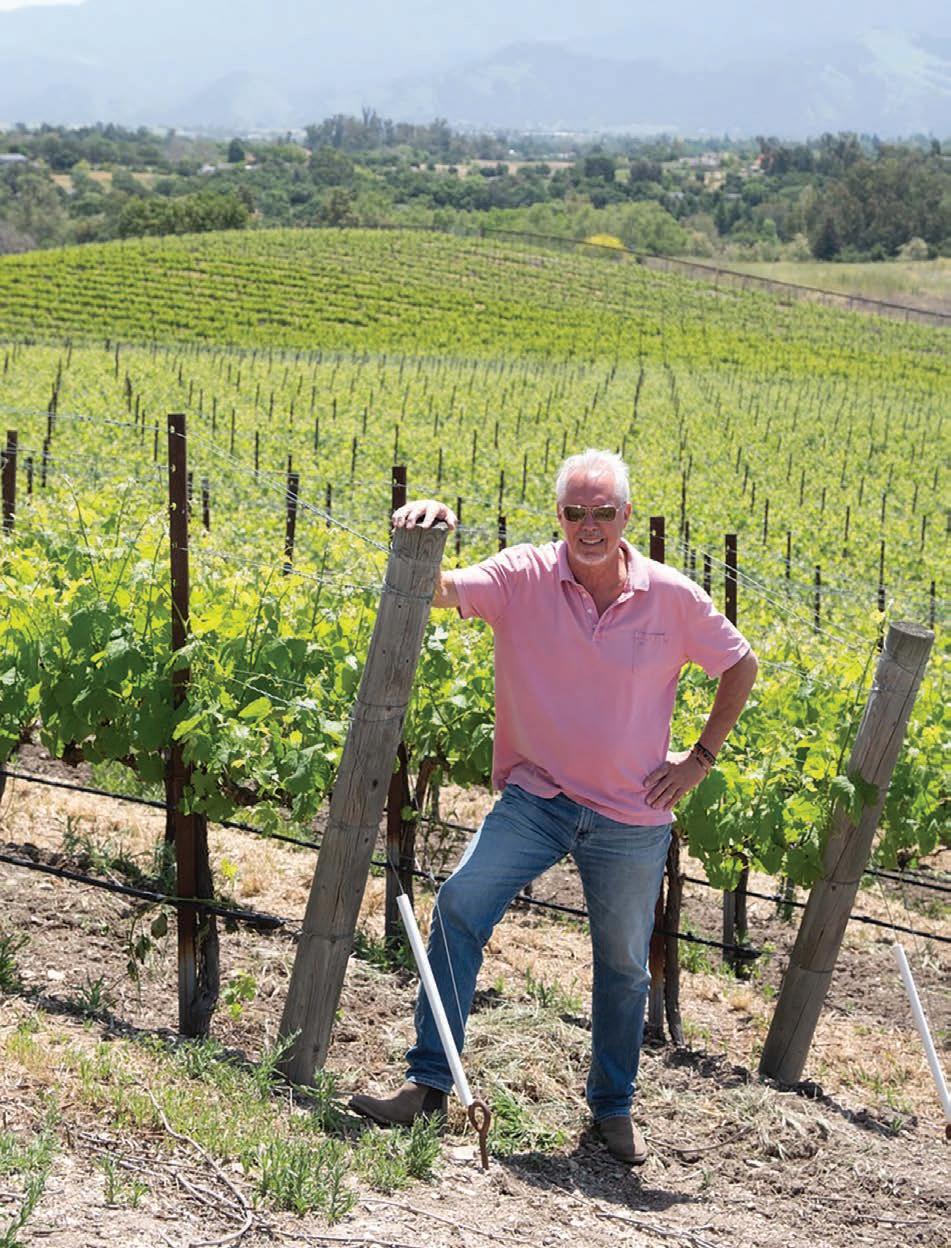
23
The spirits of Rock 12 turning heads in Sta Rita.
26
“Bossa Nova Brunch” at the Belmond.
30
The grand Granada celebrates 100 years.
50 Tasting in the hills of Sta Rita.
54 Q + A with Santa Barbara County star winemaker, Doug Margerum.
58 Vine evolution
A brief history explains how the wine industry of Santa Barbara County went from a local hobby to an international destination.



























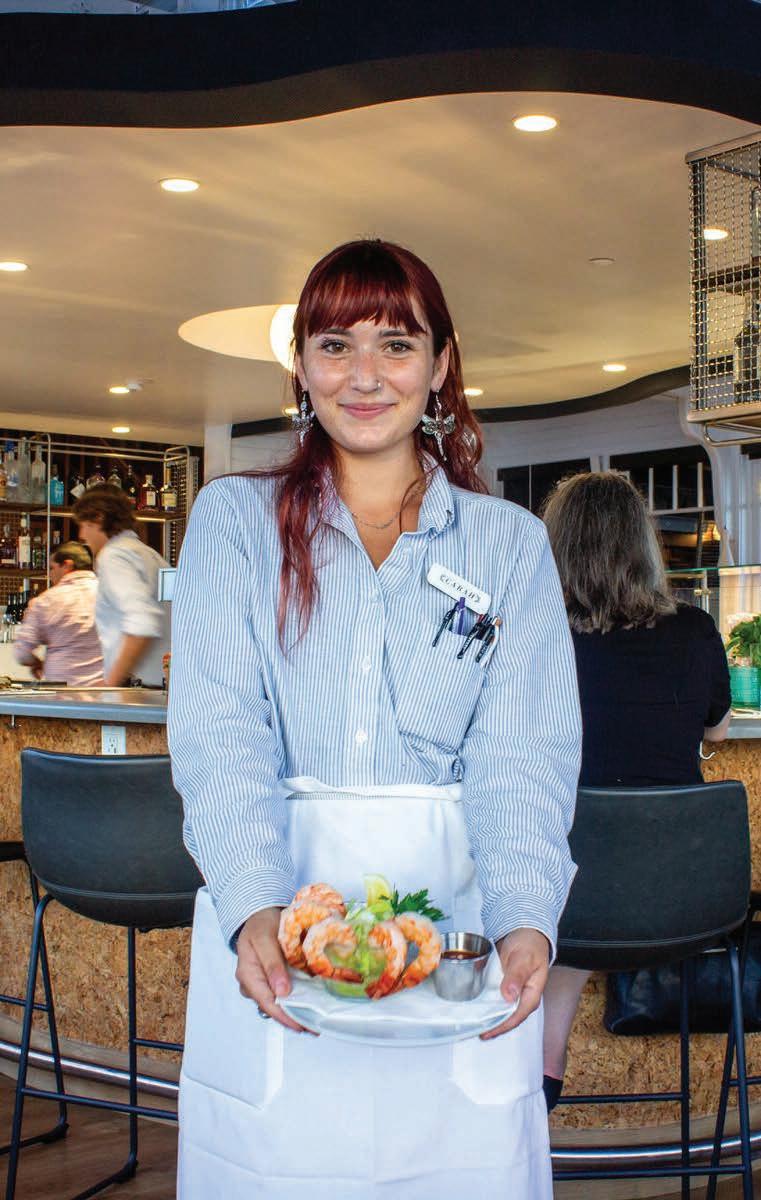
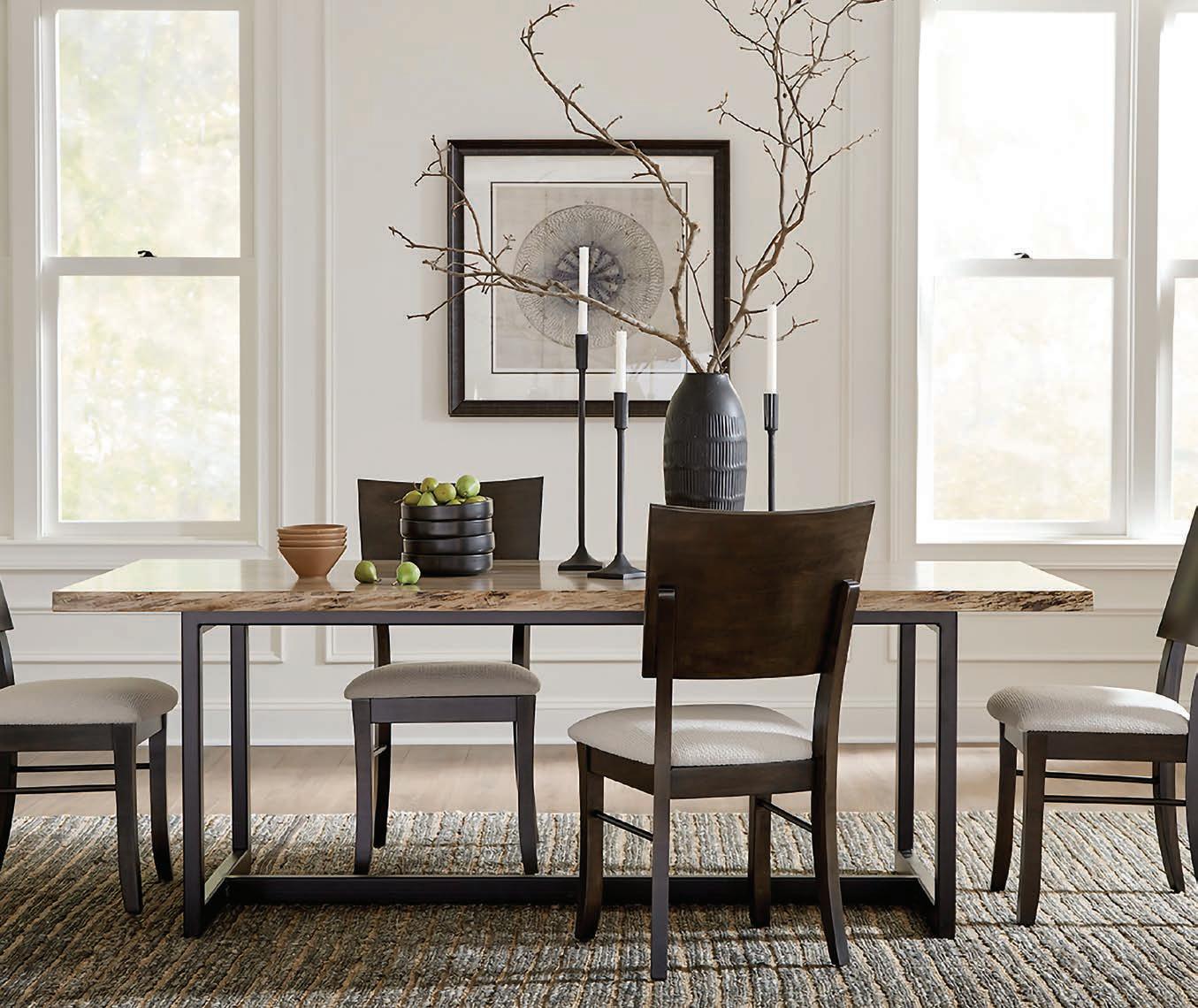






PublIsher & PresIdent
Philip Kirkwood
phil@food-home.com
dInIng & CoP y edItor
Jeff Miller
WIne edItor
Hana-Lee Sedgwick
travel edItor
Leslie A. Westbrook
desIgn & ProduCtIon
Buffalo Brothers Studios
ContrIbutors
Raymond Bloom
Lisa Cullen
Danielle Fahrenkrug
Laurence Hauben
Marshall Howen
Lynette La Mere
Nancy Ransohoff
PhotograPhy
Jim Bartsch
Joshua Curry
Eliot Crowley
Braulio Godinez
Ashley Hardin
Katherine Knowlton
Eamonn McGeough
Carly Otness
Kim Reierson
Shelly Vinson
soCIal medIa Consultant
Kara Pearson
ContaCt InformatIon P.O. Box 20025, Santa Barbara, CA 93120 (805) 455-4756 www.food–home.com
Food and Home (ISSN# 1533-693X) is published quarterly by Metro Inc. and single copies are provided to selected homeowners free of charge. Unless otherwise noted, all photographs, artwork, and designs printed in Food & Home are the sole property of Metro Inc. and may not be duplicated or reprinted without Metro Inc.’s express written permission. Food & Home and Metro Inc. are not liable for typographical or production errors or the accuracy of information provided by advertisers. Readers should verify advertised information with the advertisers. Food & Home and Metro Inc. reserve the right to refuse any advertising. Food & Home® is a registered trademark of Metro, Inc. Copyright © 2019. All inquiries may be sent to: Metro Media Services, P.O. Box 20025, Santa Barbara, CA 93120, or call (805) 455-4756, or e-mail: info@food-home.com.



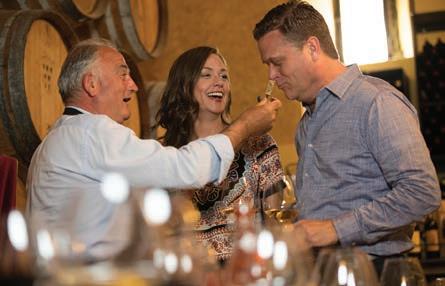
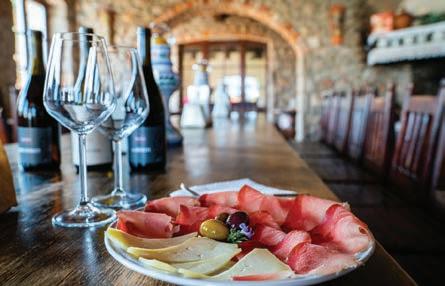




Europe is a treasure trove of history, vibrant cities, and delectable flavors, off ering endless opportunities for discovery. With Celebrity Cruises, you can immerse yourself in this rich tapestry with over 40 overnight stays in 11 of the continent’s most dynamic cities, including Florence, Venice, Copenhagen, Lisbon, and Istanbul. Six award-winning ships cover the continent from top to bottom. For the first time, Celebrity Infinity ® will be sailing the Mediterranean year-round, allowing you to explore Europe to the fullest.
Leave No “Must See” Unseen. In addition to Europe, Celebrity Cruises sails around the globe. Ask Santa Barbara Travel about special culinary and wine cruises, bucket list destinations and once in a lifetime experiences.
Book your next Celebrity Cruises vacation with Santa Barbara Travel by December 31, 2024 and receive an exclusive $200 shipboard credit for balcony or higher category
SANTA BARBARA MONTECITO 1028 State Street Santa Barbara, CA 93101 (805) 966-3116
1485 East Valley Road, #9 Montecito, CA 93108 (805) 969-7746

Laurence Hauben
Born and raised in France, Laurence began her culinary training at age three. A cooking teacher and chef, she is available for small group and private events, specializing in seasonal menus centered around Santa Barbara’s organic produce and local seafood.
To learn more, visit www.marketforays.com

Jeff Miller
Jeff Miller is a longtime newspaper writer/editor who now writes books and plays. His novels can be found at amazon.com/ author/jdmillerauthor or at Lulu.com under J.D. Miller.

Hana-Lee Sedgwick
Hana-Lee Sedgwick is a writer, editor, and marketing consultant born and raised in Santa Barbara. A certified specialist of wine and sommelier, she loves sharing the world of wine with people, and happily spends her downtime eating, drinking, and wandering throughout California wine country and beyond. Follow her on Instagram @ wanderandwine.


Nancy Ransohoff
Nancy Ransohoff is a writer and editor who’s worked at Bon Appetit, Architectural Digest, and Frommer’s guidebooks. She currently writes for 805 Living magazine and covers Santa Barbara area restaurants for Westways magazine. She was a writer and editor for the guidebook “Hometown Santa Barbara,” and loves to help show off this beautiful place we’re lucky enough to call home.

Leslie A. Westbrook
Leslie A. Westbrook is an award-winning journalist who covers travel, food, design, and people. She also assists clients around the globe desiring to sell fine art, antiques, and collectibles via international auction houses. Leslie can be reached for a complimentary consultation at LeslieAWestbrook @gmail.com.
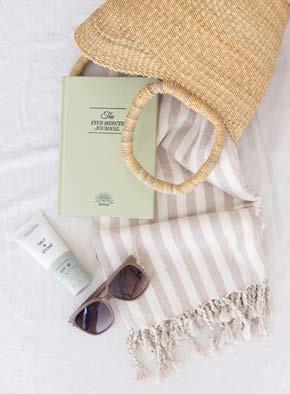
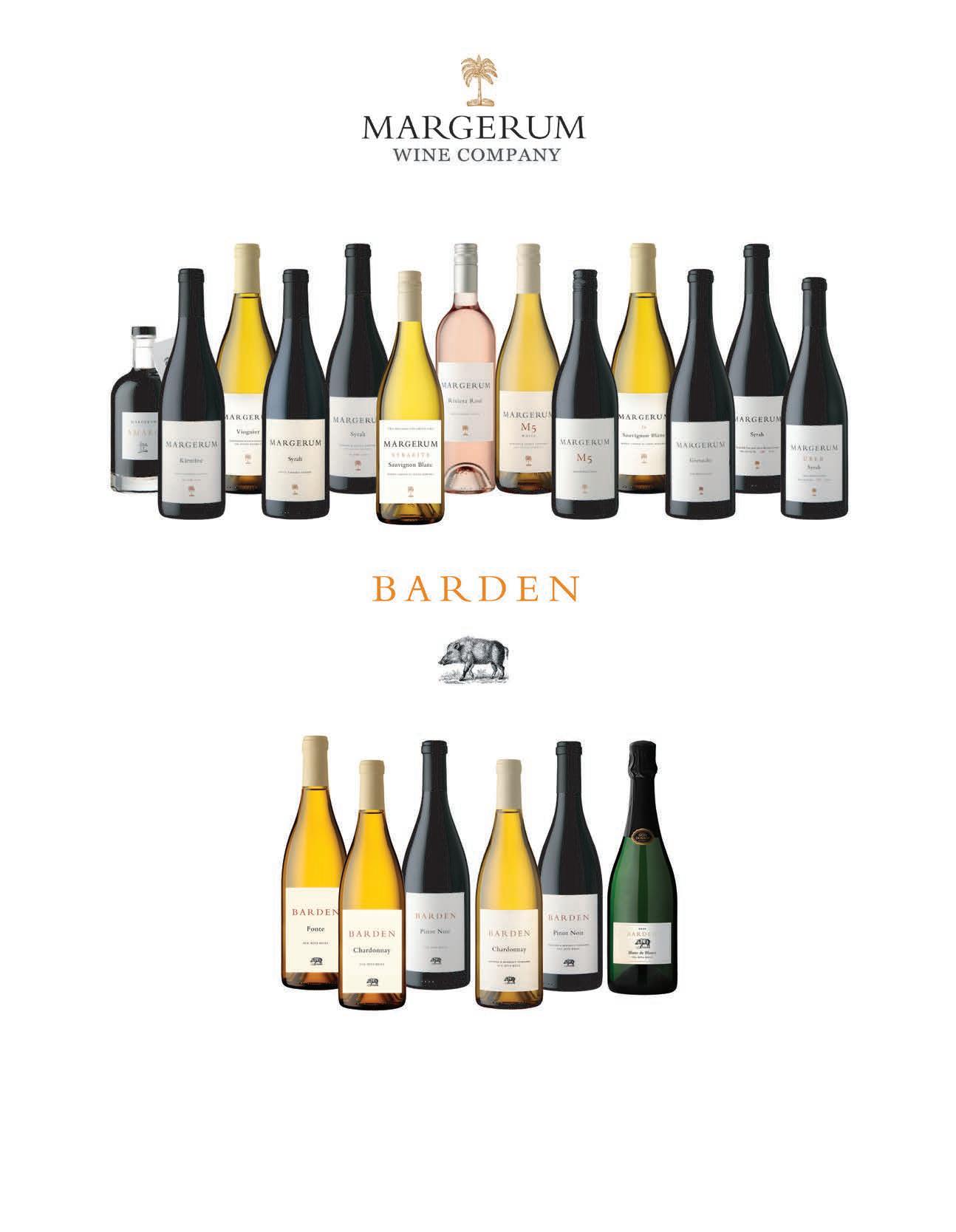
Tasting daily at the Margerum Tasting Rooms
Hotel Californian, 19 East Mason, Santa Barbara and 2446 Alamo Pintado Ave., Los Olivos
Margerum & Barden wines are available at margerumwines.com, fine restaurants and premium retailers.







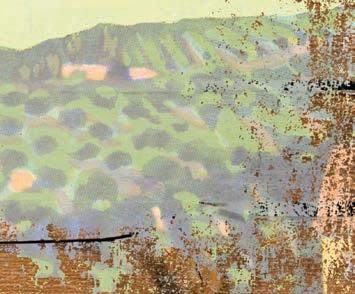




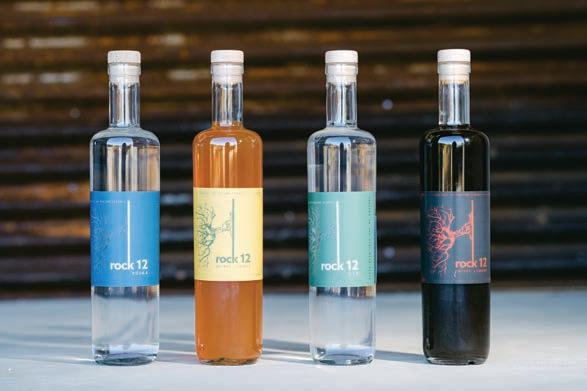

by Bob Wesley
Here’s a cocktail recipe combining improbably disparate ingredients that were fused to create one stunning outcome:
First, factor in the centuries-long Serbian family tradition of home distillation. (Forget about the Americanism “a chicken in every pot.” There, it’s more like “a still in every garage.”)
Add plenty of tenacity from an engaging young American couple originally from San Berdoo, inspired by the alcohol-based art form perfected by their Old World forebears.
Toss in a llama farm just six and a half miles west of Buellton.
Import a big eye-catchingly handsome and handmade copper contraption built in the motherland that alchemizes ephemeral vapors into luscious inebriants.
What could be conjured up from this unlikely amalgamation? Rock 12 Distillery, featuring a disarming assembly of vodkas, liqueurs, and brandies at a palate-enervating stop on Highway 246.
In 2016, Sarah and Marko Suput ripped a page from his family’s history book and began the process of conjuring up a commercial distillery here in Santa Barbara County. Seven years later, after loads of physical labor and an innumerable set of vexing hoops, forms, and licenses, they pulled off the impossible, opened in 2023 and are prospering in the heart of nearby wine country.
They can even mix and serve cocktails at their bar. The temptations here are countless. Come on up and taste! I sure did:
The citrus-centric straight vodka is glossy, sensually textured, and would be intensely
desirable on its own in a frosty martini up or certainly on the rocks with an accompanying lemon twist AND one (or three) almond stuffed olive(s).
There is also an herbaceously spicy Serrano chili-infused iteration that should without any doubt be the basis of your next Bloody Mary, and the purity precludes masking it with any additional capsaicinbased hot sauces.
Finally, a refined hibiscus-predicated bottling will turn a standard Cosmopolitan into a rapturous pre-dinner libational triumph via the ruddy, floral perfume and immodest mouthfeel.
Next, Sarah and Marko introduced their liqueurs: The coffee-based rendition is sourced from local Zaca Roastery in nearby Buellton, and flaunts an abundance of chocolatey
caramel on its brazenly plush framework.
A first for me was a quince-based rendering with such a precise gravitational aromatic pull that I was prompted to purloin their apropos tasting note: “apple pie in a glass.” Expect nearly wicked, glyceriny impact on the palate. This stuff would outrage a Public Decency Committee.
The last liqueur, Victus Amaro, is bittersweet, floral and a far superior vermouth substitute for all you Negroni and Manhattan predilectionists out there. It was voted best liqueur in 2023 by the John Barleycorn Society, a competition against heady worldwide participants.
The finale included two brandies. The first was made from local wine that was then distilled and aged for two years in barrels, and like a Cognac VS, it harbored the spicy, woody intonations and silken dried fruits that would make any renowned French distillateur grudgingly admit parity, if not defeat.
The apple brandy, despite the multitude of highlights preceding it, was the ultimate temptation of the day for me. Suave and sexy, it maintained impeccable balance, staying light on its feet, yet fanning out for complete satiation of every critical taste and mouthfeel receptor. As Robert Parker once noted about a wine, “It must be tasted to be believed.”
Sip it neat by the fire and contemplate immortality.
Or immorality for that matter…
Cheers! Or as they say in Serbia, Živjeli!
For tasting reservations and more info visit www.rock12distillery.com



After 48 years and many trips to Zihuantanejo and other costal cities in Mexico, Café Playa Azul owners Dee and Ignacio Elias brought back their inspiration for the signature seafood offerings they serve at their stylish downtown Mexican eatery. Fresh halibut, wild white Mexican shrimp and fresh diver scallops lead the way in what is considered California/ Sonora style Mexican cuisine.
The Tacos de Pescado features fresh grilled halibut with roasted tomato-jalapeño salsa, pico de gallo, avocado, fresh lime, and choice of flour or corn tortillas.
The Mexican wild white shrimp are
sautéed in tequila, butter, garlic, onion, and fresh lime juice. The scallops are sautéed with onions, tomatoes, and pickled jalapeños.
Chef Ignacio says this dish is spicy, but not hot. All of these signature offerings pair wonderfully with a house-made pineapple margarita and a side of fresh guacamole and chips. Enjoying this perfect bite in the heart of the Presidio district downtown on their heated patio before a concert at the Bowl or Lobero Theater is truly a local’s delight. –RB
914 Santa Barbara Street www.laplaya-azul.com

There’s a special breed of buyer’s remorse that tends to be experienced in good restaurants. It comes when you’ve been seated, you’ve studied the menu, you’ve made your selection, and then you see other diners being served other dishes. And then you think, “Damn, why didn’t I order that?”

What comes quickly next is the part where you ignore public embarrassment and whine to your server, “What was that?!” It all happened to us when we visited El Encanto on the Riviera for its famous Sunday “Bossa Nova” Brunch. We’d heard raves about this event from our cousins, and finally we were experiencing it. First of all, the setting. Then the music. Then, of course, the food: People who love eggs benedict have a problem. When they see it on a menu, a kind of Benedictine reflex kicks in. It must be ordered. Scientists believe the lemon/ butter combo strikes a deep chord that must be obeyed. Happens with chicken piccata too. And so, too many of us ordered it. Then we saw
tantalizing delicacies being ferried to other tables.
by Jeff Miller
“What was that?!” I wailed to Will, our server.
“The Guava Cinnamon Roll,” he said with sympathy. He’d clearly heard this before. After the golden creation was placed on the neighboring table, in front of an annoyingly smug diner, another server compounded our distress by arriving with a gravy boat from which he poured a warm nectar over the roll. “What was that?!” I wheedled. “That was the spiced cream cheese icing, sir,” Will answered patiently.
More of the same followed. There came the Blueberry Ricotta Lemon Tapioca Crepes.
Then the Brown Butter Banana Brazillian Chocolate Waffle. Then the coup de grace: the Churrasco Style USDA Prime Skirt Steak and Eggs. The names alone were enough to blow us down.
As you’ve noted from those names, the event has earned its “Bossa Nova” cred by incorporating dishes with a samba groove. Such as the Chilaquiles, which also wafted by leaving us (jealous) amid a fragrant whiff of eggs, nopales, cilantro, cotija cheese, salsa verde, and much more.
And speaking of names, you don’t have to be much of a linguist to understand that “El
Encanto” means “The Charm.” But if you need verification for that, Michelin gives the hotel five stars, and the description includes phrases like, “…a multi-year renovation leaves Belmond El Encanto in stunningly fine form.”
Part of that renovation involved an overhaul of the patio upon which the “Bossa Nova” Brunch was served, and it was, in fact, stunning, with its panoramic view over Santa Barbara Harbor.
The “Bossa Nova” part, on the Sunday of our visit, was provided by the piano/guitar duo Alyse Korn and Téka Penteriche, and it was every bit as tasteful as the brunch.
In summation, a visit to El Encanto’s Sunday “Bossa Nova” Brunch is unlikely to disappoint. But if you’ll take a bit of advice, arrive early, position yourself in an innocuous location for at least 10 minutes, observe the dishes going by on sumptuous parade, then make your selections. And presto: No buyer’s remorse for you.
Belmond El Encanto. 800 Alvarado Place, Santa Barbara. 805-845-5800.

Custom, handcrafted dining tables and more, priced at about what you’d pay for typical, above average factory-made furniture that ships halfway around the world.
Each of our stunning tables is handcrafted by the designer right here on our own South Coast. We use only hand-selected solid hardwoods throughout... No plywood, no particle board and no paper-thin veneers. These are heirloom quality, numbered and signed by the designer.
All our creations are custom made to order in about four to six weeks, depending on the design.
View the entire collection on our website, and give us a call or send an e-mail for exact pricing and scheduling.
Trade accounts welcome.

Several years ago, Karl Hutterer, president and CEO of The Stearns Wharf Company decided to make it his personal mission to rebrand and rejuvenate the forgotten Wharf eatery, Moby Dick, into a seafood culinary destination that Santa Barbara’s harbor has always needed.
Says Hutterer, “I envision Moby Dick to be a culinary delight that offers superb seafood and craft cocktails, locally sourced and sustainably produced, and a place that delights guests with programs that not only feed the body but also the soul.”
He started by remodeling the front of the restaurant into a first-class oyster bar and then hiring two locally seasoned pros, chef Alberto Torres, formerly of Boathouse Restaurant and Bluewater Grill, and Amado Simon, formerly of Beachside Café, to make the transition happen. The duo quickly

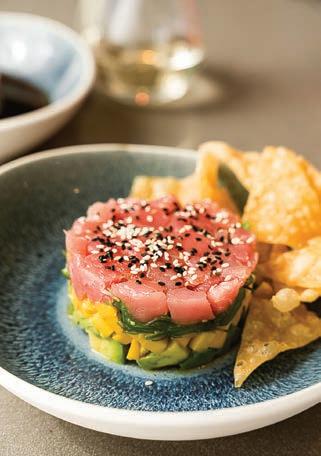
fashioned a four-star oyster menu that offers a wide assortment of oysters from the best of the East and West coasts, including Vancouver’s Fanny Bay and Prince Edward Island’s Malpeques.
Chef Torres brought his years of talent to the raw bar experience with his personal scallop and tuna crudo recipes, as well as his halibut and tuna ceviche. Other plates include steamed clams and mussels, peel-and-eat shrimp, shrimp and chips, and his raw-bar platter for sharing that includes 10 oysters, six clams, six mussels, eight peel-and-eat shrimp, and a lobster cocktail. Torres says he works daily with local fishermen to bring the freshest and most sustainable seafood menu possible. A menu that finally
A menu that finally matches the million dollar Pacific Ocean view.
matches the million dollar Pacific Ocean view. Moby Dick has been reborn. As for the cocktails, Simon has taken command of this area with his own specialty offerings that include Moby’s Mai Tai, a concoction of orange and pineapple juice, orgeat, dry Ferrand curacao, and dark Whaler’s rum served on the rocks. He says it’s better than anything you’ll find in the Islands. Simon also recommends his Mezcal Basil Mash with fresh basil, mezcal, fresh lime, and tajin to give it the spice.
Simon notes the bar also includes local brews from Draughtsmen Aleworks in Goleta and adds that about 95 percent of the wine list is sourced from Santa Barbara County and the Central Coast.
Torres and Simon both agree that the process is ongoing and that the menu will keep getting better with the addition of prime-grade meats and local in-season spiny lobster.
Torres says to keep an eye out for his special twists on surf & turf. Updates to the back portion of the restaurant are coming, too, to better accommodate the upscale dining feel. “We’re going all out on everything from our happy hour (they call it “Oyster Hour”) to regular wine pairing dinners,” says Simon. “Come for the crafted food and drink and stay for the million-dollar views!”
Phil Kirkwood
Moby Dick is on Stearns Wharf. Oyster Hour is 3pm to 7pm Monday thru Friday with live music featuring local talent from 6pm to 8pm on Thursday. www.mobydicsb.com

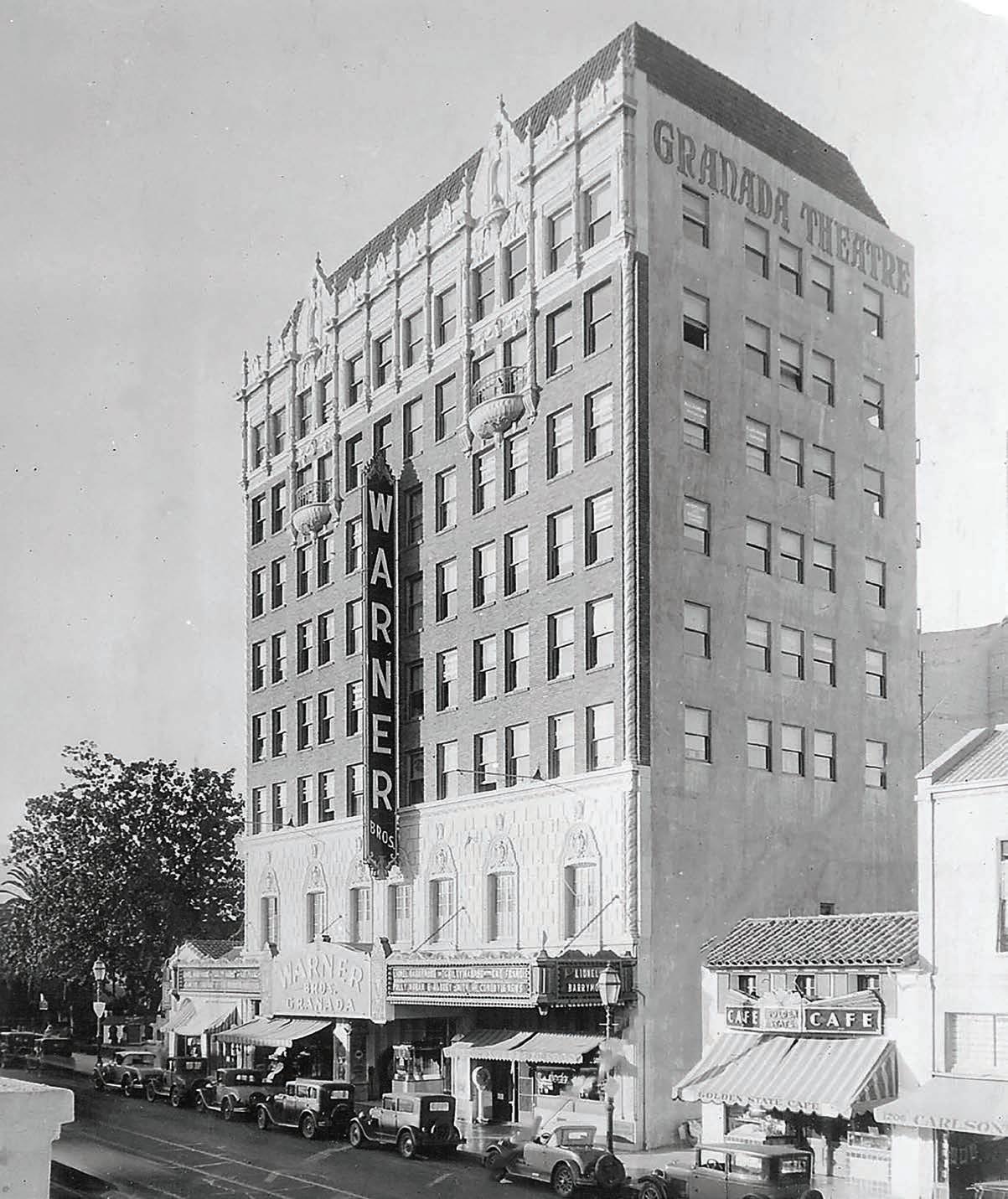

‘This building isn’t going anywhere’
Celebrating a century of the unshakable Granada Theatre
Acritical moment in the 100-year history of Santa Barbara’s iconic Granada Theatre transpired 23 years ago. It changed everything. Leading up to that moment, the theatre’s operator had filed for bankruptcy. In the wings, some New York City investors were moving to purchase it. Who knows what might have happened had the deal gone through.
A possible extreme example was the destiny of LA’s California Theatre, designed by the same architect as the Granada. The California, which also fell on hard times, ended up showing X-rated movies in a desperate effort to survive. It didn’t work. The theatre was demolished in 1990.
As for the Granada, a meeting with the New York operators was set. They were on their way, unless fate intervened. Then fate did.
The meeting was scheduled for Sept. 11. The year was 2001. The New Yorkers never made it out of New York.
Instead, days later, a different kind of meeting took place. Building owner Rob Rossi had lunch with Santa Barbara’s premier philanthropist, Michael Towbes. “Here’s what we’d like to do,” Towbes said, according to centennial producer Scott Seltzer. “And Rossi said, ‘Yeah, okay.’”
That’s just how it happened, Rossi said in an interview. “Mike [Towbes] was interested in trying to establish that part of State as an arts center. All credit on Mike’s shoulders. He helped shepherd it through the permit process. I thought it was a great idea. And we contributed half of the theatre’s value [$3,250,000] to the effort.”
“It was serendipitous,” Seltzer said. The preservation of local control “made all the difference.”
That difference has been plain to see this year, as the Granada celebrated its centennial. With the support of Towbes, plus other major donors such as Sara Miller McCune and Roger and Sarah Chrisman, as well as hundreds of Santa Barbarans, the theater carried on, leading to a massive, six-year, $60 million renovation. And what evolved in the end is more than just a theater in a state-of-the-art building. “They did a magnificent job,” building owner Rossi said.
by Jeff Miller
The evolution was born of the desire for serious local involvement. As related in the Granada’s own centennial story, “The Santa Barbara Symphony required better natural acoustics, a significantly wider proscenium arch, and a stage with a shell and wing space. Opera Santa Barbara required a wider proscenium as well as a much deeper stage. State Street Ballet needed a flexible floor to help protect dancers’ physical well-being. UCSB Arts & Lectures needed all the above plus lighting and sound reinforcement technology consistent with the needs of contemporary touring dance and music attractions. All eight companies were unanimous in their expressed desire for more, and better, dressing rooms.”
All of which led to the $60 million renovation campaign, including the addition of a seismic retrofit. Reopened on March 6, 2008, the result was and is “a world-class performing arts center,” in the words of Caren Rager, the theatre’s Chrisman executive director and president. That seismic retrofit was to assure the Granada “would stand for the next 100 years.”
Which takes us back a century to the theatre’s birth, when architect A.B. Rosenthal hired local builder Charles Urton to erect Santa Barbara’s first and only high-rise (other than the 76-foot Balboa Building). The problem was, while Urton had built homes for Hollywood’s elite, he’d never attempted a skyscraper. In 1924 the phenomenon was still fairly new, the first coming only 39 years earlier in the form of the Home Insurance Building in Chicago, made possible by the innovation of using structural steel-reinforced concrete.
What to do? Urton made a common-sense move: “He sent away for books on how to build a high-rise,” Rager said. The result, rising eight stories and 119 feet tall, opened on April 9, 1924, and was put to an extreme test just over a year later in the form of the famous June 29, 1925, earthquake, measuring 6.3 on the Richter scale. The quake destroyed 85 percent of the commercial buildings downtown, as well as the twin towers of Mission Santa Barbara, but the Granada sustained only minor damage.

According to local lore, builder Urton went up to the building’s roof to check its condition and a policeman on the street below yelled at him to come down. He rejected that. “This building isn’t going anywhere and neither am I!” he reportedly shouted. And he unfurled a banner cannily announcing that Charles Urton had erected the building. “He included his phone number on it,” Seltzer noted. It’s said he had plenty of work after that.
By law, passed by the City Council in 1930, the Granada remains Santa Barbara’s tallest building.
And as if there wasn’t enough serendipity surrounding the Granada’s history, here’s more.
As art of the permitting process during the theatre’s extensive renovation, an environmental assessment was required. And part of that assessment included a survey for prehistoric cultural remains. A young archaeologist named Laurie Pfeiffer was assigned. At that point Pfeiffer herself disclosed a remarkable coincidence: that she is builder Charles Urton’s great-granddaughter. “It was a complete coincidence,” she said in an interview. “They weren’t aware.”
The assignment gave her the opportunity to study up close the care that her greatgrandfather had poured, literally, into the Granada. “As a part of the archaeological survey, I was allowed to venture below the basement floor to see the giant steel pilings drilled into the sandstone,” she said. “He used the strongest steel and the richest concrete. He spared no expense. He wanted to make sure Santa Barbara’s first high-rise stayed standing.”
That the building withstood the 1925 quake was ample evidence that he did it right.
“It was a pretty spectacular experience for me, as the building has always been an important part of our family’s legacy in Santa Barbara,” Pfeiffer said.
The Granada board hosted a luncheon for the Urton family during the centennial celebration. Present were the builder’s grandchildren, great-grandchildren, greatgreat-grandchildren, and other relatives.
Planning for the centennial celebration “started about a year ago,” said Jill Seltzer, vice president of advancement. “We put a lot of hours in, a lot of thought, and it really paid off.” The events began with a performance by the Antonio Artese West Coast Trio on Feb. 22, followed by an April 3 screening of “The Granada: Celebrating 100 Years of the Arts in Santa Barbara,” now streaming on YouTube. That was followed by the major weekend celebration, April 12-14, starting with two films that were once shown on the theatre’s screen: Sherlock Jr. featuring Buster Keaton (which fittingly debuted in 1924) and 1977’s Star Wars: A New Hope. Said Jill Seltzer of the latter, “It ran for 15 weeks. People wrote letters saying please change the movie.”
Other highlights included a performance by the 40-piece Pacific Jazz Orchestra, and a show highlighting Santa Barbara’s own upand-coming stars, including Hunter Hawkins, Jackson Gillies, Rachel La Commare, and production numbers from the spring musicals of Dos Pueblos, San Marcos, and Santa Barbara high schools. Prices were cleverly

geared to the passage of the century, from $19.24 to $21.24, for the future.
Over the century since its creation, countless stars have shone on The Granada’s stage and screens, but since the renovation a key focus has been to make it a community gathering place. Said Jill Seltzer, “We’ve hosted weddings and memorial services, including one for Mr. Towbes when he passed. It’s very much a multi-use building.”
Seconded Scott Seltzer, “That’s been the mission of the building from its inception, and the motivation for the restoration, which continues today: to be a gathering place for the community. Maybe that’s the reason it’s lasted while others haven’t.”
How many performers have graced the Granada’s stage over its century? The answer is beyond counting. But here’s a partial, modern-era list:
Loggins and Messina, Joshua Bell, Michael McDonald, London Symphony Orchestra, Steve Martin, Foreigner, Alvin Ailey Dance, The Moody Blues, Paw Patrol Live!, Carmina Burana, Dave Mason Unplugged, Bernadette Peters, Tony Bennett, The Beach Boys, Ali Wong, David Crosby, Boz Scaggs, Ken Burns, Lil Buck, Yo Yo Ma, Jazz at Lincoln Center/Winton Marsalis, Ballet Hispanico, Herb Alpert, and Lani Hall.




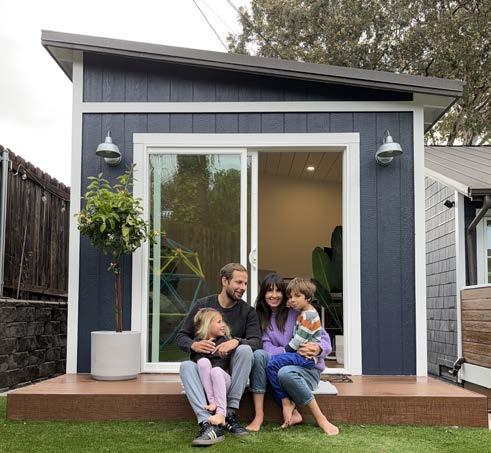


Slide on wire awning systems offer an elegant look and the ability to create your own shade or sun when you need it. You can control the hot sun during the day and see the stars at night. Slide on wire panels are made to open and close on a stainless steel cable. The Sunbrella fabric panels come with a 10 year warranty and the steel or aluminum frame tubing are custom made to order and feature a powder coat finish.—RB
Van Nuys Awnings for your outdoor experience. www.vannusawning.com 818-782-8607
T his gorgeous Italian pottery wine carafe is a good way to serve your favorite bottle of wine and makes a great gift too! This is handmade and hand painted ceramic serveware from Tuscany and features bees and fruits –lemons, grapes and pomegranates.
Italian Pottery Outlet 929 State Street
805-564-7655
www.italianpottery.com
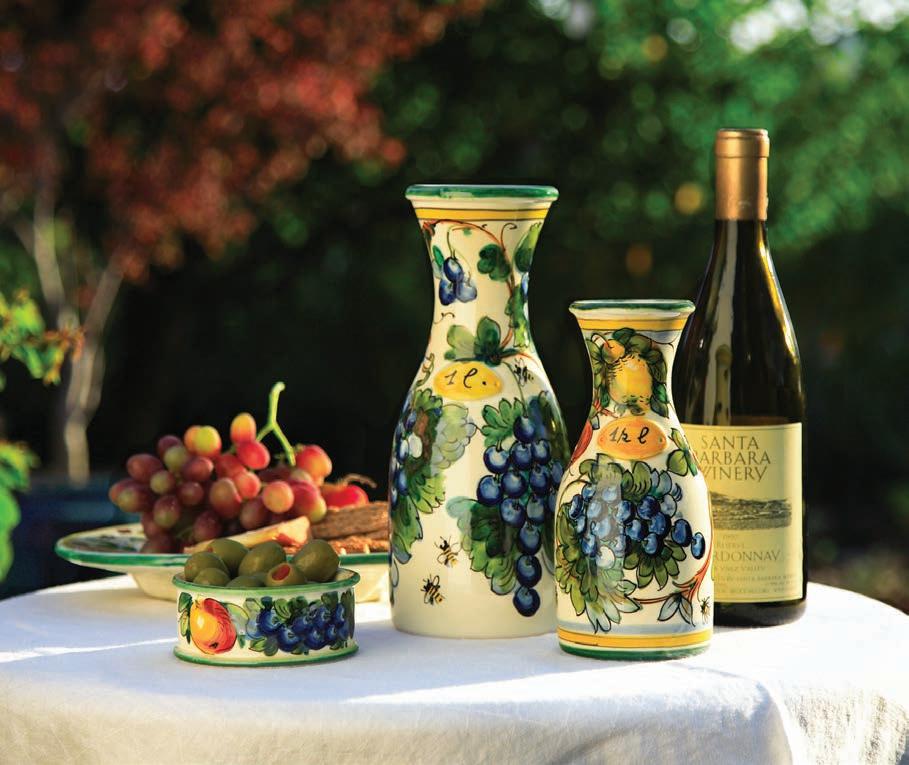
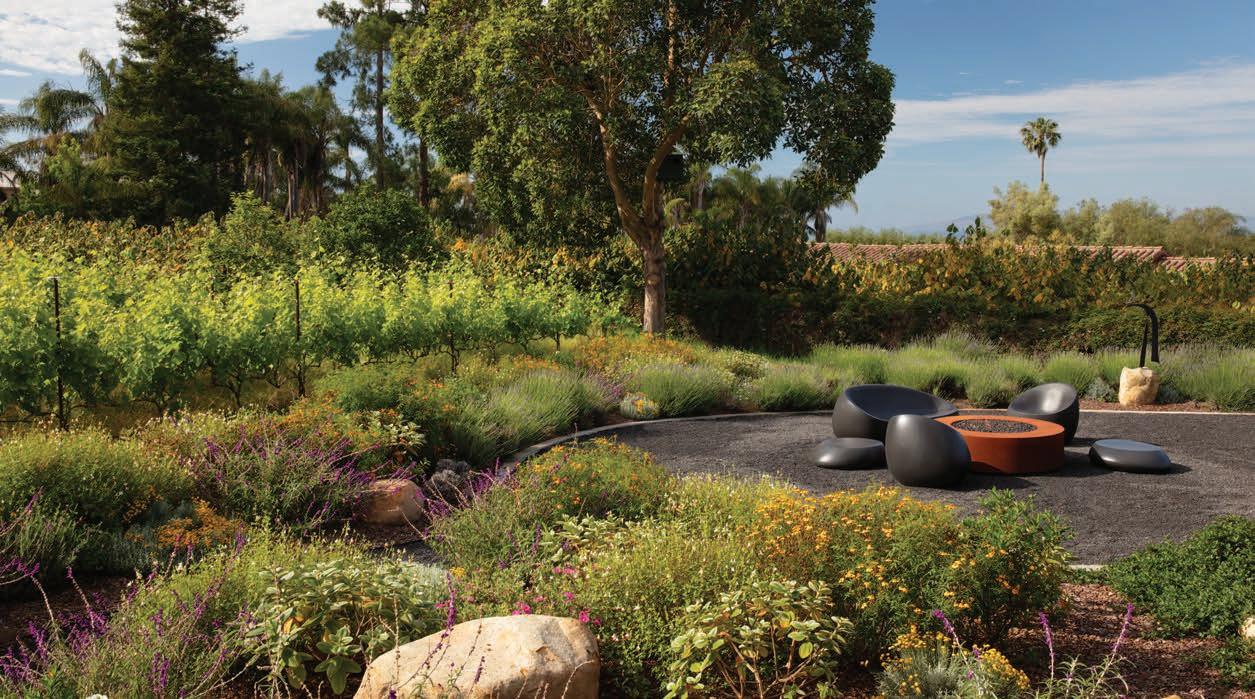
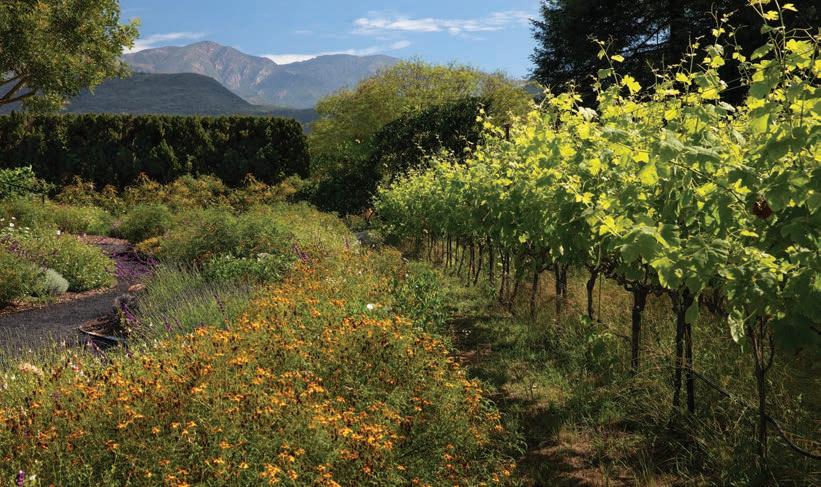



By Marley Finman
LEEWAY WINE GLASSES, Macher, shopmacher.com.
2. VISKI WINE HOLDER, House of Rio, houseofrio.com.
3. NAMBE “CURVO” WINE RACK designed by Steve Cozzolino, Coast 2 Coast, coast2coastcollection.com.
4. DIANE KEATON X HUDSON GRACE black striped linen napkin, Hudson Grace, hudsongracesf.com.





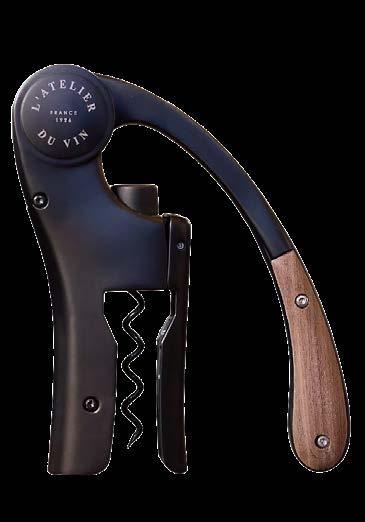
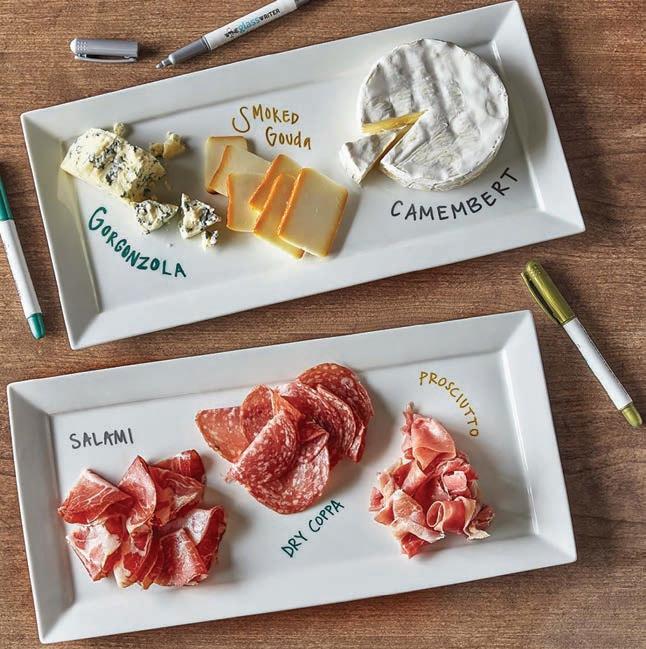
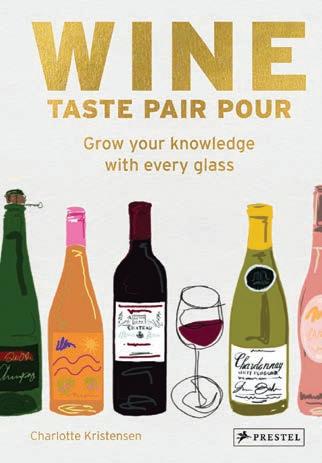

5. WINE CHILLER BUCKET, Arhaus, arhaus.com.
WINE TASTE PAIR POUR by Charlotte Kristensen, Tecolote Book Shop, tecolotebookshop.com.
7. L’ATELIER DU VIN MOTION OENO CORKSCREW, Anthropologie.com.
8. FROM A TO ALL ROUNDED TRIANGLE COASTERS, set of two, Sirena, shopsirena.com.
9. WINE GLASS WRITERS, set of three, Sur La Table, surlatable.com.
10. METROKANE RABBIT BOTTLE STOPPERS, set of four, Sur La Table, surlatable.com.
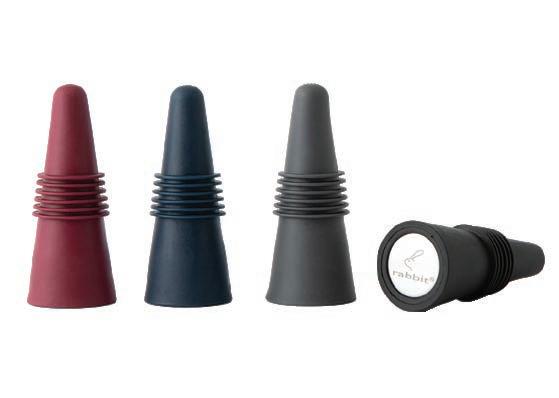
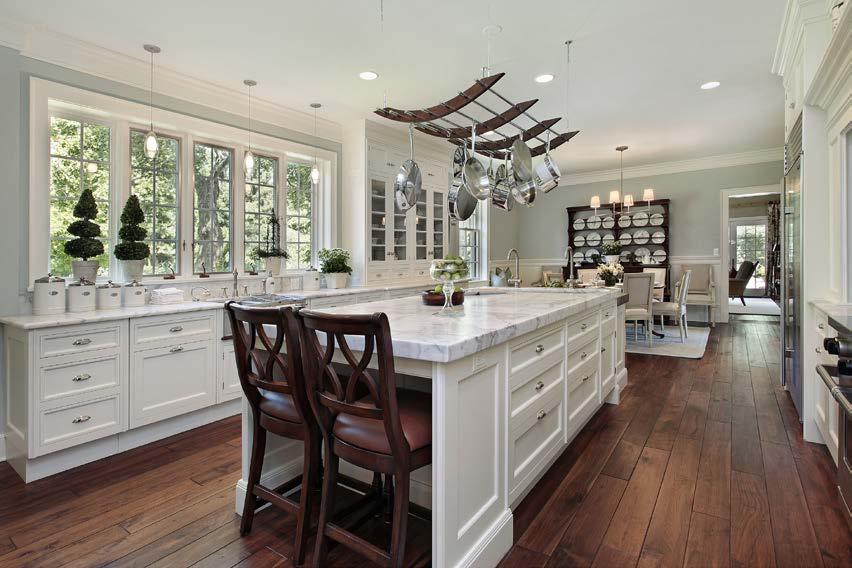



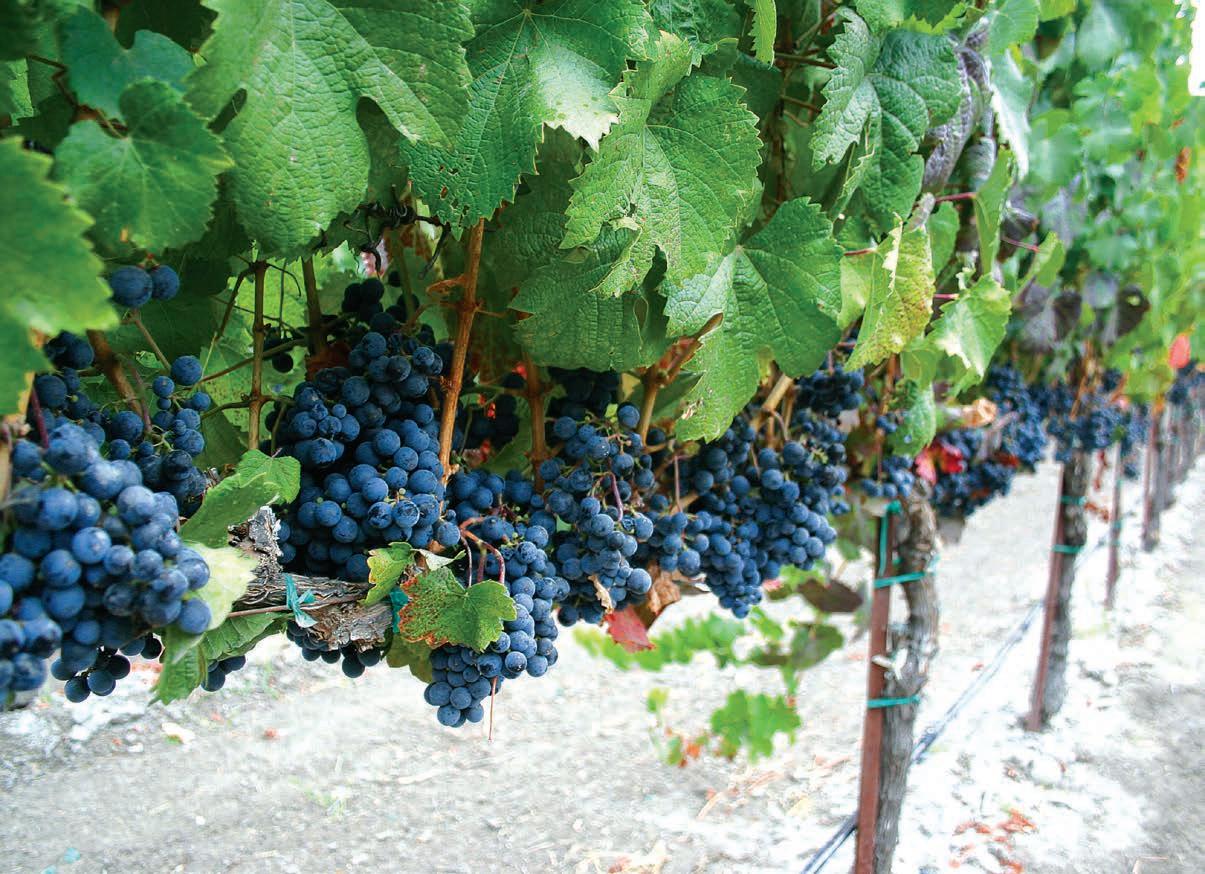
by lIsa Cullen
In Santa Barbara County, its harvest time! The most exciting and busiest time of year. Perhaps the notion of having your own vineyard appeals to your romantic nature. Making wine is one thing, but most winemakers will tell you that growing grapes for wine is an entirely different discipline.
These tips are for a backyard vineyard, a hobby vineyard, something done for fun, not a commercial endeavor. The good news is that you don’t need acres and acres to experiment with some planting some wine grapes. In fact, it’s likely best to experiment with a small plot or arbor before replacing your entire landscape with wine grapes.
Location is everything: Grapevines do best with full sun and will grow in a variety of soils, but good drainage is vital, their roots tend to grow deep. If roses do well at your
As far as how many vines to plant, the rule of thumb is that you can get about three bottles of wine per grapevine.
site, then grapes may work because they have similar demands of water, sun, and air flow.
Planting on a south-facing slope is ideal. Choose varieties wisely: The grape variety you plant will depend on your location. In Santa Barbara, you’ll need to plant grapes that like cooler temperatures.
Trellising on an arbor: Trellising is important as grapes are rambling vines, grow well on an arbor, and this way can be grown in very little space. A standard arbor could be established in an 8 x 8-foot area. Larger arbors could be developed as desired. A grape arbor can be built over a patio where you can then place table and chairs and enjoy the shade.
Planting: Organic methods are best when you’re eating the fruits of your harvest. It’s essential to add life to the soil with lots of compost.
As far as how many vines to plant, the rule of thumb is that you can get about three bottles of wine per grapevine. NOTE: It takes about five years of tending before your first harvest, so don’t be in a hurry. You can spend that time learning!
Tending the vines: There are many philosophies about pruning and trellising. Fortunately, there’s plenty of time between planting and harvesting to study up. With all of the vineyards in Santa Barbara County, I’m sure you could work in several (who wouldn’t want a bit of free labor?) to get your hands dirty and learn.
Winemaking: Before making wine (remember you have five years), you might consider joining the Central Coast Home Vintner’s Association (www.cchva.org). Based in Santa Maria, the association consists of over 100 home-based wine makers who collaborate, sharing knowledge and expertise, and they have cooperative equipment for crushing, resources for buying grapes, and even can supply corks.
Enjoying the fruits of your labor
Growing grapes for winemaking is not for the faint of heart. But like any activity requiring know-how and hard work, the rewards are worth it. Gardening is a lifelong passion and when you delve into the art of wine, it bodes for a long-term relationship.
Lisa Cullen, landscape designer and organic gardener, owns Montecito Landscape with her husband, Chris. She can be reached at 805.969.3984 or www.montecitolandscape.com
Resources : Wine Spectator
University of California-The California Garden Web



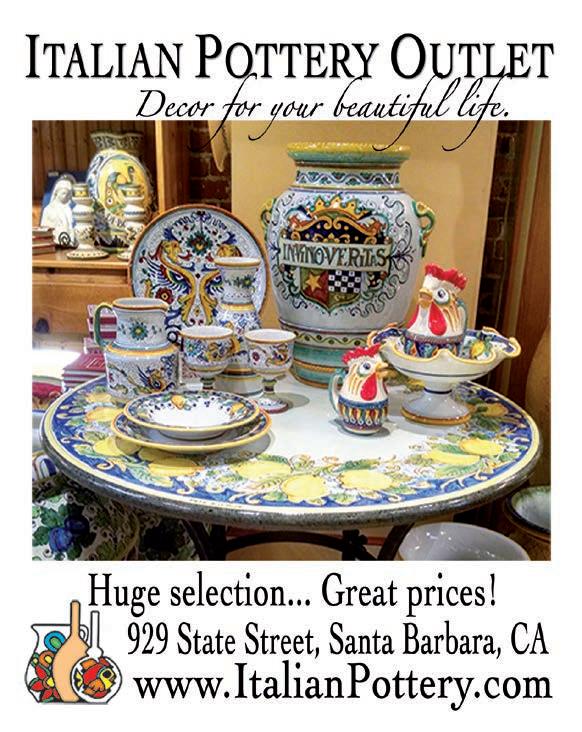

by marshall hoWen
The last four months have seen quite a move forward on the Central Coast with regard to battery technology. Across the bridge between utility scale and “behind the meter,” components continue to be refined and modified to meet the growing needs of consumers. For evidence of this, simply look to the new 50-megawatt Tesla Energy Storage site that was commissioned in Goleta. Or spend just a moment looking at the number of new energy storage systems that have come to market. It’s really something to witness the growth and increased demand.
With this great increase in demand, it goes without saying that the energy storage industry is changing and evolving rapidly. For residential applications, the need for a safe, simple, and cost-effective solution seems to drive most development. But as you can imagine, there are quite
a few constraints to integrating a partial-home or whole-home backup battery system.
Most residential batteries have evolved into a lithiumbased chemistry. Tesla has traditionally used a lithiumiron phosphate (LFP) battery, because of its lighter weight and charge/discharge capabilities. Similarly, some manufacturers use an adapted lithiumion chemistry for energy storage units. This adaptation sacrifices some energy density performance but the battery is much more stable, allaying real concerns about the fire hazard of other chemistries.
Other lithium-based structures for batteries often fall in the “NMC” or even “NiMH” categories. These chemistries are heavier, but allow for faster charging and capacity. They’re preferred for power tools, E-bikes, but also for certain car batteries. But cobalt is very expensive so again, from a
manufacturing standpoint and with the end consumer in mind, while nickel-based batteries have higher density and are preferred, consumers want a lower-cost basis for the components they want in their homes.
Aside from the evolution of battery chemistry, other great advantages that the industry is seeing are in the way batteries are being configured. Companies like Briggs & Stratton and Anker Solix1 are coming to market with stackable units, rated for outdoor installations. These provide the ability to capture some savings because they tend to be easier to install. We’re seeing great interest in larger systems too, as the utility company continues to increase the cost of electricity. High Time-of-Use bills have seen a 15-20 percent increase since this time last year, mostly as Central Coast Community Energy has inserted its Solar
Billing Plan across our area. As a consumer trying to decide on if an energy storage system is right for you, spend some time evaluating the “users” of electricity in your home. It’s fun talking with folks about their “must-haves” when considering what they want backed up during a grid outage, but there’s usually a sizeable gap of not understanding the impact of larger loads (i.e. air conditioning, electric vehicles, electric range, etc.) and the need for a larger system. Knowing what you need, and knowing the benefits and characteristics of battery components/chemistry, will set you on a path of being satisfied with what you choose.
Marshall Howen has been involved in the solar and energy storage industry for over 20 years and is the president and founder of Sunrise 805. www.sunrise805.com








Help take your water efficiency to the next level by replacing your water-thirsty lawn with water wise plants.
- $2.00 / square foot of eligible lawn replaced.
- Single Family Residential and Small Multi-Family Residential (1-4 dwelling units): $1,500 maximum rebate.
- Commercial and Large Multi-Family Residential (5+ dwelling units): $2,500 per meter serving irrigation, maximum of $5,000 per property.
- Additional $250 downspout disconnect incentive.
- Rebate amount is based upon square footage of lawn removed. Projects must be approved in advance.


APPLY FOR A REBATE NOW. SCAN HERE
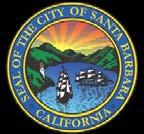

“Ozzie & Elliot”
Bronze Open Edition
Dimensions:
Ozzie: c. 4”H x 3”W x 4”D (left)
Elliot: c. 2” H x 3”W x 5”D (right)
Available as a set or separately. www.susanreadcronin.com
18 x 24 original oil painting by Ralph Waterhouse. Featured now at the downtown location.
Waterhouse Gallery La Arcada Plaza 1114 State Street, Suite 9, Santa Barbara Montecito Location: 1187 Coast Village Rd 3b 805-886-2988 www.waterhousegallery.com


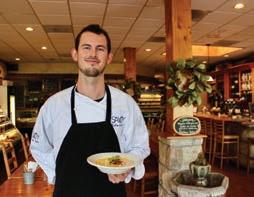
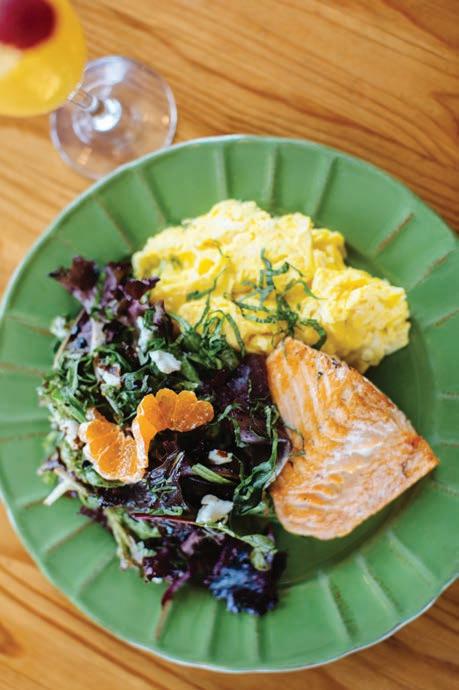

By Leslie Andrea Westbrook
Paso Robles is jumping these days. Witness the Nomad Hotel Group’s recently opened Paso Robles lodging (their second), The River Lodge (www. riverlodgepaso.com), an Instagram-worthy, 21st-century converted motel located 101-adjacent, between downtown Paso and Tin City. Just 28 rooms with patios and hammocks surrounded by lush plantings, and also featuring a well-designed open-air restaurant, Ciao Papi, that serves pizzas and pastas. The outdoor cocktail bar is adjacent to the adults-only pool and hot tub. Also “dog friendly,” The River Lodge is a reasonably priced base for exploring wineries, downtown restaurants, and more. Make reservations at sure-fire dining spots: Breakfast in town at Brunch. Pop in for lunch at Etto Pasta Bar in Tin City (don’t leave without a bag or box of their organic semolina Etto pasta). Or enjoy a leisurely fantastic lunch amidst the vines and wine-tastings at Justin Vineyards and Winery. Check out nightly dinner specials at The Hatch downtown. Book a soak in Paso’s natural mineral springs at Rivers Oaks Spa and keep on eye on the refurbishment of the historic Paso Robles Inn (under new ownership/ management) with in-room mineral soaking.
pasoroblesinn.com
Luxury direct to Napa on Aero
Semi-private jet service Aero recently added direct flights from Van Nuys airport to Napa Valley Airport just in time for fall harvest. Travelers arrive 20 minutes prior to takeoff, sink into Italian leather seats in the up-to16-passenger Embraer 135, sip a complimentary glass of Verve Cliquot champagne, and enjoy Erewhon nibbles onboard during the approximately one-hour flight to wine country. Aero also has teamed up with Napa Auberge Resorts for added perks for passengers: the airline’s luggage policy allows two checked bags and two cases of wine (no additional cost) on Napa/LA return flights.
Aero also flies to Aspen, Sun Valley, and Cabo San Lucas. Be on the lookout for future destinations. Flights to and from Van Nuys/Napa (and vice versa) are scheduled twice weekly, with fares starting at $725/each way.
www.aero.com
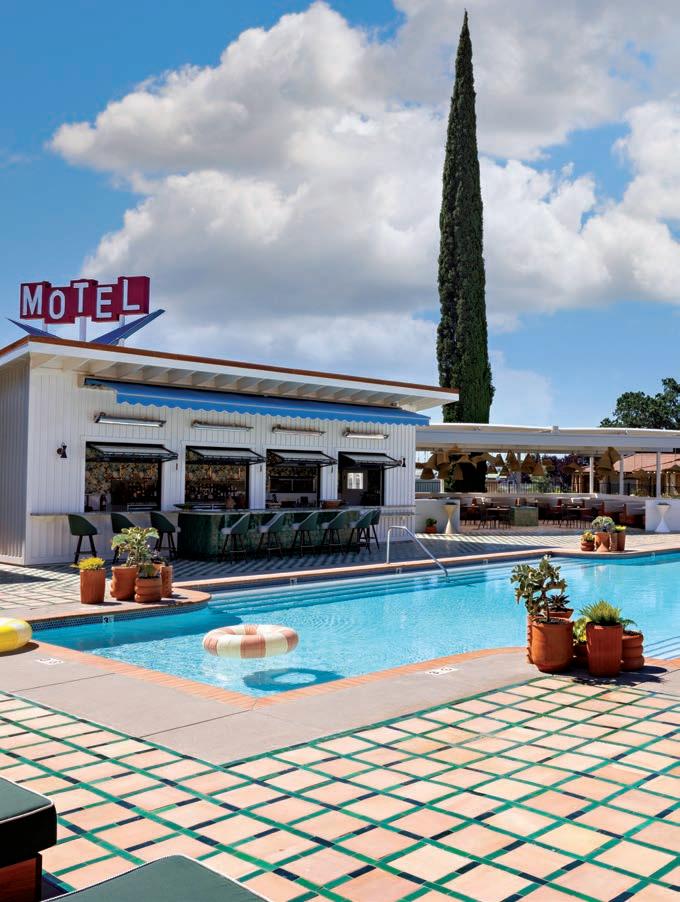

Locally owned and operated, we are Santa Barbara’s travel experts.
Our knowledgeable and experienced advisors can help you navigate the world. We specialize in cruise and custom tour planning and as a member of the exclusive Virtuoso Travel Network have relationships with the best luxury travel companies and hotels worldwide.
For peace of mind when you travel. WWW.SBTRAVEL.COM
We Cover the World
VACATION • BUSINESS • ENTERTAINMENT TRAVEL




SANTA BARBARA
1028 State Street
Santa Barbara, CA 93101
(805) 966-3116
MONTECITO
1485 East Valley Road #9 Montecito, CA 93108 (805) 969-7746



By Hana-Lee Sedgwick
SANTA BARBARA
COUNTY, renowned as a world-class growing region, is home to seven different AVAs. While each appellation boasts its own unique characteristics, from diverse terrains and soils to varied grape varieties, the Sta. Rita Hills AVA stands out as one of the most celebrated.
Declared an AVA in 2001, the Sta. Rita Hills, a sub-AVA of the Santa Ynez Valley, is distinguished by its close proximity to the Pacific Ocean. Here, transverse valleys funnel maritime influences inland, with foggy mornings and breezy afternoons moderating temperatures to allow grapes ample time to develop flavor and acidity. The region is also noted for its ancient, mineral-rich soils, such
as diatomaceous earth, which contribute complexity to its cool-climate wines — including pinot noir, chardonnay, syrah, and gamay.
To fully appreciate this region and the beautiful nuances of its wines, a visit is essential. While there are plenty of worthwhile wineries to explore (and definitely do try them all!), we’ve narrowedh down six that seamlessly showcase what this remarkable region has to offer.
Founded in 1996, family-owned Melville Winery is praised for its 100 percent estate wines and commitment to sustainable, organic farming practices. The estate tasting room, situated along Highway 246, offers a casual, inviting atmosphere where you can sip winemaker Chad Melville’s acclaimed pinot noir, chardonnay, and syrah wines just steps
from where the grapes are grown. To enhance your experience, book an immersive private tour and tasting, which includes time in the vineyards to understand Melville’s dedication to winegrowing from grape to bottle.
www.melville.com
For 40 years, Bryan Babcock has produced noteworthy Burgundian, Rhône, Bordeaux, and other French varietal wines from his estate winery, located on the property his parents purchased in 1978. The tasting room, a 5,000-square-foot converted barrel warehouse, exudes the creative energy of Bryan and his wife, Lisa. Within the eclectic, retro-meets-rock ’n’ roll setting, you can sip tasty wine, listen to ’70s tunes, and explore vintage goods and curated art. It’s a laid-back, funky, and convivial tasting room unlike any other in the area. www.babcockwinery.com
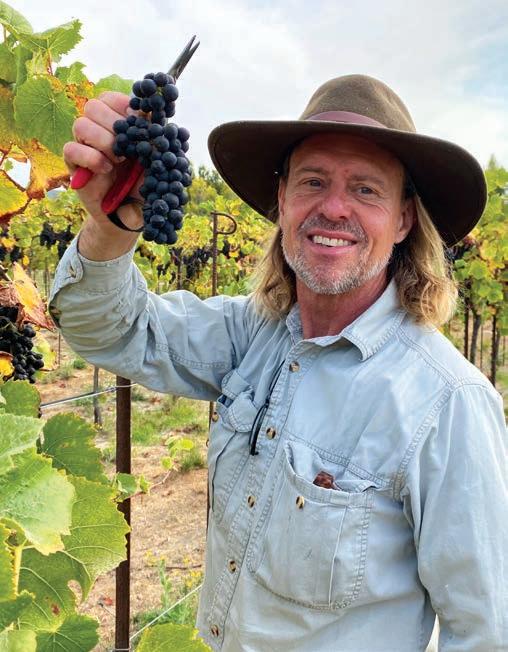
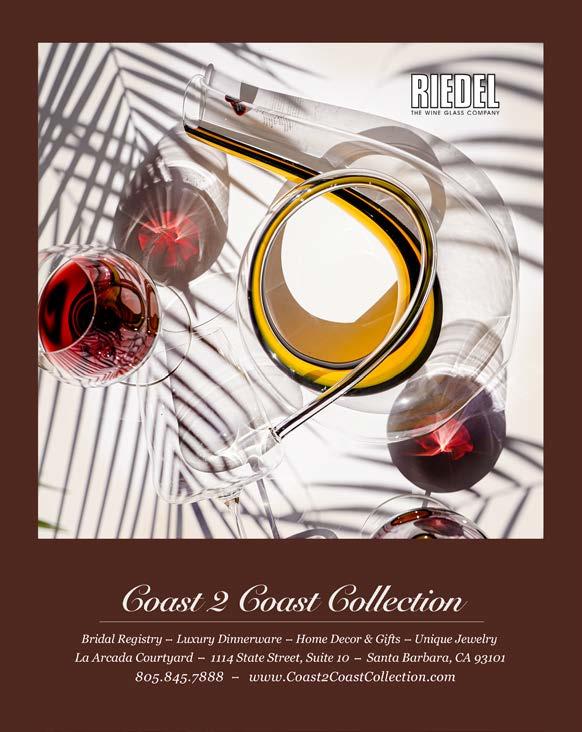
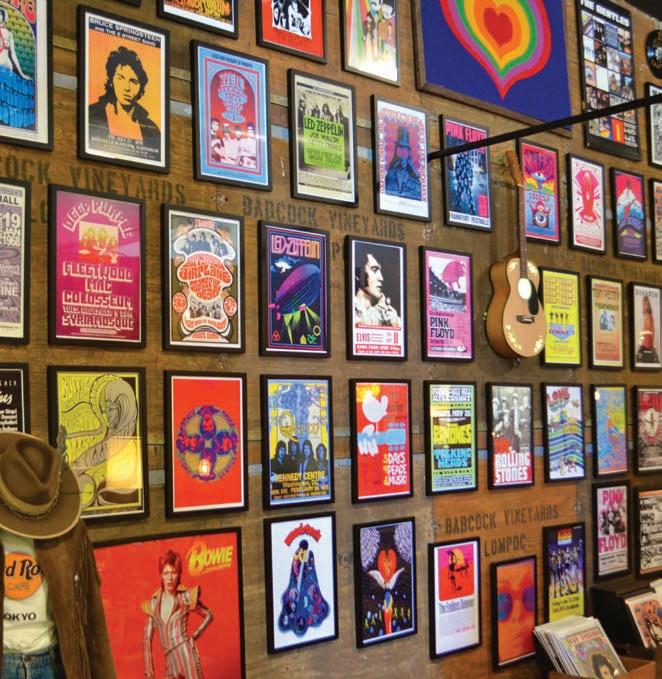

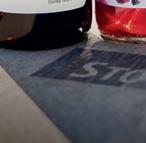


Family-owned winery focused on producing classically styled wines from Santa Barbara County. Visit our tasting room in Los Olivos!


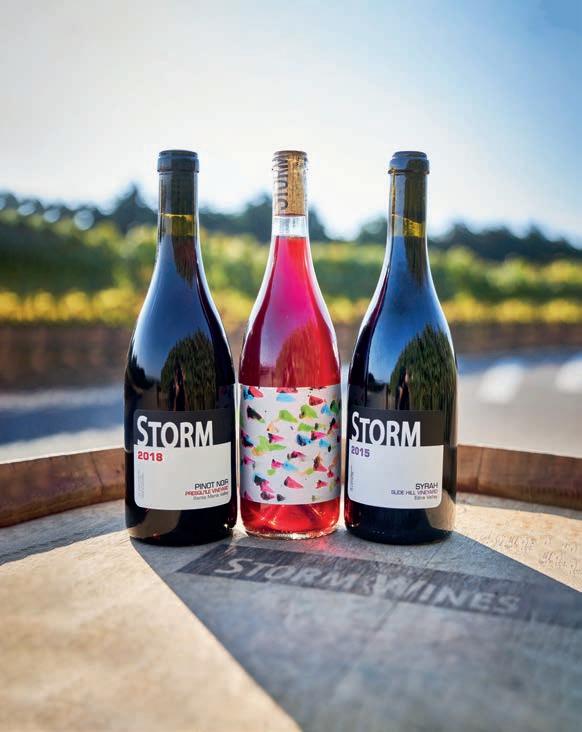
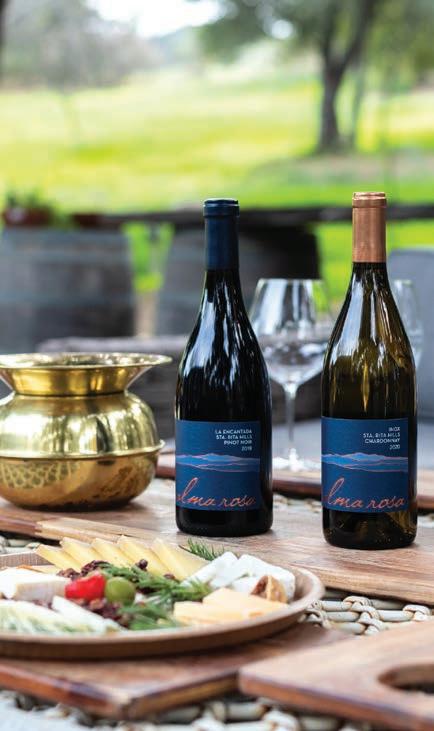
Founded in 2008, The Hilt quickly ascended to prominence with the opening of The Barn at The Hilt Estate in 2021, a stunning space that showcases the premier wines of both The Hilt and sister brand, JONATA. With its expansive ceilings, rustic yet sleek decor, fireplaces, and communal tables, The Barn offers an elevated, moody setting perfect for enjoying meticulously crafted wines — many sourced from The Hilt’s dramatic nearby vineyards: Bentrock, Radian, and Puerta del Mar. To delve deeper into the nuances of these vineyards, book The Point tasting, an exploration of pinot noir and chardonnay from these rugged sites. www.thehiltestate.com
This 105-acre estate, located on the eastern end of Santa Rosa Road, is home to 50 acres of vines featuring several different clones of pinot noir, chardonnay, syrah, and grenache. Visitors can enjoy Peake Ranch’s exceptional estate wines from its chic outdoor patio, where views of the natural surroundings create a relaxed vibe. On Saturdays, the winery also offers walking tours of the vineyard, with stops for wine. www. peakeranche.com

Founded by Santa Barbara wine pioneer Richard Sanford, Alma Rosa is renowned for its cool-climate, limited-production wines, including chardonnay and pinot noir. While the winery welcomes guests to its Solvang tasting room, the best way to experience Alma Rosa is by visiting its historic 628-acre ranch in the Sta. Rita Hills. Reserve the Outdoor Hike Experience for a guided tour through the picturesque property, followed by a private wine tasting at the century-old ranch house.
www.almarosawinery.com
Since 2005, Justin Willett has produced exceptional wines from Santa Barbara’s cool growing regions. Though widely available at top restaurants, you can now taste Tyler Wines at Justin and Amanda Willett’s picturesque Mae Estate, located along Highway 246. From the chic and serene vineyard house, enjoy a private, seated tasting with spectacular views of the property’s 28 acres of vines.
www.tylerwinery.com
Designing in Santa Barbara County for Over 30 Years
“Karen is wonderful!
Great eye for design and I am very pleased with her work. I would highly recommend her!”
- Tammy Milovich, Santa Barbara
Call for Free Consultation 805-340-4608

www.karenandrea.com

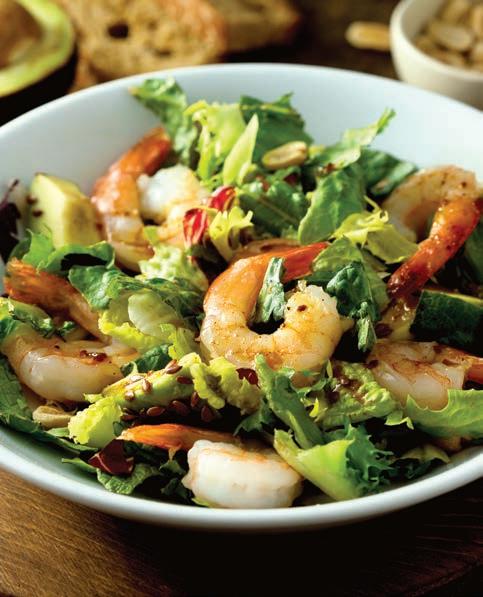




You might say winemaker Doug Margerum has been around the block a few times when it comes to fine food and wine. He’s been a leader in the Santa Barbara and Santa Ynez wine and dine scene for over 35 years. In 1994, his flagship restaurant, Wine Cask, became one of only 74 restaurants worldwide to earn the Wine Spectator Grand Award.
Since selling the restaurant in 2007, Margerum has devoted all of his time to his current venture, Margerum Wine Company, a company that was born in a 240-square-foot cold room in the back of Brander Vineyards in Los Olivos, CA. The company now features a
state-of-the-art winery facility in neighboring Buellton, two tasting rooms (one in the Funk Zone in Santa Barbara and a second in Los Olivos), both featuring well-paired casual cuisine to accompany the fine wines and worldclass tasting experience.
Margerum has gone from just a few cases in 2001 to a top local producer of over 26,000 cases including 10 Rhone varietals, a Chardonnay, a Pinot Noir and a Sauvingon Blanc. Earlier this year, Margerum’s top seller, M5, earned 17th place on Wine Spectator’s top 100 wines worldwide.
“I used to be a sommelier when I ran the restaurant,” Margerum says. “Now that
I’m a full time winemaker things are a little different. I still have the knowledge base and service standards that a sommelier needs to know and I’m proud to have those skills in my repertoire.” Just for fun, he says you may soon find him at bouchon, a leading fine dining spot in Santa Barbara, as guest sommelier “That’s if Mitchell [Sjerven, the owner] lets me do it.”
Food + Home Magazine managed to sit down with Margerum for a few minutes during this busy harvest season to talk about the local wine industry, the success of Margerum Wine Co. and the people who helped along the way … past, present and future.


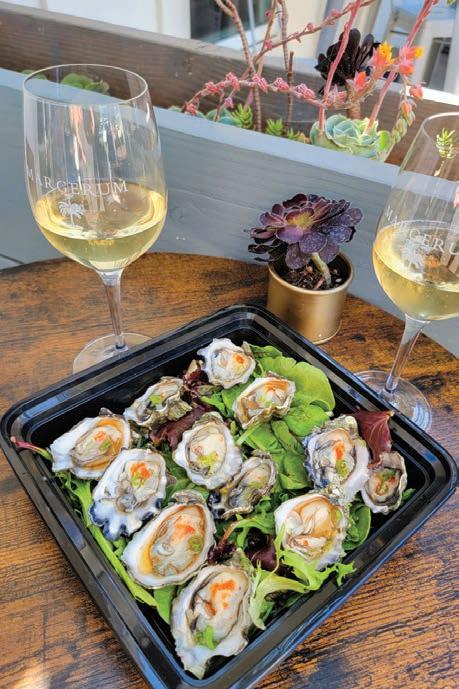
What was the first wine you ever made and how did you get from there to where you are now?
Early in my career, I had the privilege of working with Jim Clendenen and Bob Lindquist at Au Bon Climat and Qupé, though I wasn’t the winemaker. After leaving that partnership, I launched my own winery in 2001, where I crafted my first wines independently. In those early days I frequently called Jim Adelman the winemaker at Au Bon Climat for guidance. Fred Brander also played a crucial role as a mentor, offering me space in his winery to establish Margerum Wine Company and generously sharing his expertise. While I’ve gained a wealth of knowledge since then, my core winemaking philosophy from the beginning remains unchanged.
How would you describe your winemaking philosophy?
We are dedicated to crafting small-batch wines that reflect the unique character of the vineyards they come from, using only the finest grapes. Our approach is rooted in natural winemaking, allowing each wine to express its own distinct reflection of the terroir. By keeping production at a scale where we can personally tend to every step of
the process, we ensure an intimate connection with the wine from vine to bottle, standing in stark contrast to mass production. Our standards of quality are set by our own high expectations, not external benchmarks. We make wines we love, some to enjoy in their youth and others to cellar for years, awaiting future generations. We want people to enjoy our wines at the table, where they belong, with those you cherish most.
Who are your winemaking mentors and when did they influence what you do today?
As I mentioned, my mentors include Jim Clendenen, Jim Adelman, Bob Lindquist, and Fred Brander, all of whom have significantly shaped my approach to winemaking. I’ve also gained valuable insights from Billy Wathen of Foxen and Richard Sandford, while Rick Longoria has been a great source of inspiration. My winemaking style is heavily influenced by European models, reflecting my years of experience with and appreciation for wines from various French regions. For instance, my M5 white and red wines embody the character of southern Rhône, my Syrah draws inspiration from northern Rhône,
my Sauvignon Blanc is crafted in the style of the Loire Valley, and my Rosé is distinctly Provençal.
Tell us about how you developed the M5 series.
The M in M5 stands for my last name, Margerum, while the 5 signifies the five grape varieties used in both the white and red blends. The red wine combines grenache, syrah, mourvèdre, cinsault, and counoise, whereas the white features grenache blanc, marsanne, roussanne, viognier, and picpoul blanc. These blends enable me to craft more consistent and refined wines each year by tailoring them to a specific vision. They represent a culmination of my extensive tasting experiences, drawn from hundreds of producers throughout my career. Unlike many winemakers, I had the privilege of sampling thousands of wines over the 25plus years during which I curated a Grand Award-winning wine list at my restaurant.
How do you see the future of wine making evolving, especially in the context of climate change?
The future of high-quality winemaking will increasingly rely on cooler and colder climates. Although climate change is affecting weather patterns, especially in our Mediterranean region, we are experiencing more extreme temperature fluctuations, either unusually cold or excessively hot. Adapting to these changes is crucial. Fortunately, Santa Barbara County, particularly the western end of the Santa Ynez Valley, already benefits from one of the coolest and most favorable growing climates in California. There’s been a noticeable shift toward cultivating grapes further west and in cooler areas. For instance, some of our best grenache and syrah now come from the Sta. Rita Hills AVA, an area traditionally known for chardonnay and pinot noir but now successfully growing Rhône varietals.
What is the most unusual or unexpected food pairing you’ve discovered for your wines?
I’ve been most impressed with some of the pairings I’ve done with Japanese cuisine. Margerum and Barden wines tend to be a little bit lighter, and they compare beautifully with the very precise foods that you can find in Japan. Preparations like soba (Margerum Grenache), tempura (Margerum Sybarite Sauvignon Blanc and/or M5 White), tonkatsu (Margerum M5 Red), wagyu (Margerum or Barden Syrah), sushi/sashimi (Barden Fonte or Blanc de Blancs), and yakatori (Margerum Cinsault or Barden Pinot Noir).

Of all your wines, what are you the proudest of?
The Margerum M5 Red is a wine that never fails to impress and ages gracefully over time. I often call it my “desert island wine” because if I had to choose one wine to drink for the rest of my life, it would be M5 Red. What sets it apart is its ability to evolve with age, offering a dynamic and ever-changing profile that reflects the season, the weather, the food, and even my mood. No matter the occasion, it always delivers a balanced array of flavors and aromatics.
Whether it’s paired with seared ahi tuna, Bolognese, In-N-Out burgers, lasagna,
cassoulet, or grilled duck, M5 Red is my go-to choice. It complements just about anything, and I love how much other people enjoy it as well. I’ve even nicknamed it my “puppy wine,” because honestly, if you don’t like M5 Red, it’s like saying you don’t like puppies!
Receiving Wine Spectator’s #17 spot as one of the top wines in the world this year was an incredible honor, and it made me feel especially proud of a wine that consistently brings so much joy.
For tasting room hours, reservations and general info, visit www.margerumwines.com



Santa Barbara County’s wine country goes from backwater to beguiling, all at hyper speed
WRITTEN BY BOB WESLEY
Check out this list of Euro-regions and how long wines have been produced there. They don’t call it the Old World for nothin’:
Bordeaux: 1,900 years
Rhône Valley: 2,400 years
Tuscany: 7,000 years
OK? Now, consider this: It was 1964, exactly (and only) 60 YEARS AGO, when a bullish upstart named Uriel Nielson planted the county’s very first commercial vineyard. He scoffed
(and perhaps even snorted derisively) at the agricultural naysayers who claimed that Santa Maria was far too cool and windy to grow grapes and fashion wine that was actually worth a tinker’s (or drinker’s) damn.
He was a spot-on futurist, a Nostradamus without the miscues, well except for propagating cabernet, though it was a mandatory crop due to public demand. (Not so much after people tasted it.)
Critically, the Nielson site in the north county presaged the arrival of the Miller Family’s Bien Nacido Vineyard (1973), hallowed terra firma that even the

dumbest cluck from Napa can easily name and bow their head to in homage. Cue David Bowie’s “Fame” as a mental musical accompaniment.
Viticultural paydirt had been hit, yet throughout the rest of our backyard, mysteries lay fallow in the silent ground, which offered few road signs of what to grow where , even while quietly yearning to be an earthen home for wine grapes, which possessed far greater romantic cachet and sensuous attributes than humble (if nutritious) broccoli and artichokes. Gimme a glass of Syrah as nourishment over herbage any day.
Thankfully, farther south, a figurative earthquake transpired in 1971, when Richard Sanford and Michael Benedict scrutinized the fields west of Buellton as promising vineyard locations, even though Sanford has gone on record as stating that “Everyone thought this was a stupid idea.”
Yet, the twosome’s botanical, geoinvestigative and climatological testing proved not simpleminded at all, but stupendously on-the-money and prophetic. The main, noted critic of the time hailed their first release in 1976 as an “American Grand Cru in a Lompoc Barn,” the only enlightened oxymoronic phrase I’ve ever heard.
Not bad for a terrain originally planted to garbanzo beans and barley, built on
a multimillion-year-old former seabed composed of dead algae fossils.
So, the game was not only afoot, but compass-based clues were piling up. Pierre Lafond wisely followed suit and established vines a few miles from Sanford and Benedict Vineyard in Sta. Rita’s primordial days. Walt Babcock, a Seal Beach dentist, bought a hefty chunk of acreage 10 miles outside of Buellton in ’78 right on Highway 246.
His son Bryan must have felt like Kevin Costner in Dances with Wolves , planting the family flag (as well as gewurztraminer, chardonnay and sauvignon blanc) at what was then a lonely outpost.
Olivos District, the not-too-hot, not-toocold Three Bears-styled environs. Fairy tales, as Sinatra sang, can come true.
Hey, across the landscape, miscalculations were made and learned from just like in Europe, since the importance of what you plant and where isn’t just horse hockey or bullpucky. And just one freakin’ single harvest per year is the ultimate minimalist nightmare.
Think of it: By the early ’80s, trailblazer Ken Brown (who would later found Byron) had already planted the first syrah at Zaca Mesa AND was lead winemaker, also acting as headmaster at the Unofficial Academy of Vinous Studies, mentoring the likes of the late Burgundy Master Jim Clendenen, Rhône Wizard Bob Lindquist, and multi-varietal virtuoso Adam Tolmach, one helluva graduating class.
Frank Ostini and Gray Hartley were already “Sideways” by 1985’s first release of Hitching Post Pinot Noir, the Foxen Boys banded together that same year in an equally enduring juggernaut partnership, and Fess Parker laid the foundation in 1989 for his own property and brand, signing bottles for visitors in his tasting room as a soft-spoken ambassador for the principality’s everemerging, flavorsome efforts. Fame, applause, and sales were snowballing with each vintage and decade, as Robert Parker and other formerly indifferent critics and publications began to ask for samples and even show up and visit, turning the rest of America on to the Central Coast’s genesis.
“My tastings this year further confirmed what I have believed for a long time. Santa Barbara County is one of the most exciting and dynamic regions in the world.”
Eventually, the piecemeal enlightenment grew just as the unknowables fell by the wayside. There was a kumbaya spirit in the air, as a plethora of curious talents got involved.
Fanning the fame in the ’70s and over the following decades were the likes of Kate and Brooks Firestone, Dan Gainey (Senior and Junior), Fred Brander, and Tom and Steve Beckmen, in what would eventually be officially christened the Los
— Antonio Galloni
Into the ’90s, Sta. Rita Hills exploded, with the wise arrival of the Melville Family, Sea Smoke, and ampelos. Rick Longoria planted his noteworthy Fe Ciega site in 1998. Greg Brewer and Steve Clifton oversaw multiple vineyards and each site’s individuality spoke via their label, Brewer-Clifton.
The total number of vineyards there in
2024? 59. Total current acreage? 2,700. Yeah, and “Everyone thought this was a stupid idea.”
Ballard Canyon became an AVA as well as Syrah Central, with the likes of Stolpman, Kimsey, and Larner. They followed in the surefooted stylistic paths of Rhôney precursors Andrew Murray, Craig Jaffurs, and Joey Tensley, one happy purple coalition that has helped deplete my bank account and liver at the same time.
Finally, since I’ve maxed out my word count, with apologies to anyone I didn’t include, my final point is this: Uriel Nielson would be proud, as we even got a handle on cabernet! Mostly ripped out of Santa Maria where it was once firmly ensconced but never suited to grow, it now luxuriates in sunny and balmy climes where Tyler Thomas of Star Lane, Matt Dees at Jonata, and Simon Faury helming Crown Point coax Bordeaux varieties into a previously unthinkable, rapturous qualitative realm.
Napa, beware. I NEVER thought I’d be saying that…
Here’s what critic Antonio Galloni wrote in the August 2024 issue of his publication, “Vinous”: “My tastings this year further confirmed what I have believed for a long time. Santa Barbara County is one of the most exciting and dynamic regions in the world.”
No county/region/appellation or chunk of dirt on Earth has ever advanced so far so fast, with the diversity and audacious, lip-smacking allure that Santa Barbara has achieved. And I’m no paid shill … I’m just a consumer (and ex-retailer) who’s watched the grand emergence (thus far) in real time for over 40 years.
Where will the county’s wines be in 2084? In another 60 years, barring allencompassing meteorological heatstroke and viticultural dehydration, I see broader diversity as the county welcomes grapes that are unfamiliar now but that this area can grow. Our terroir is an Amish crazy quilt of soils, temperatures, sunshine, and by the way, crackerjack talent. What can’t be accomplished?


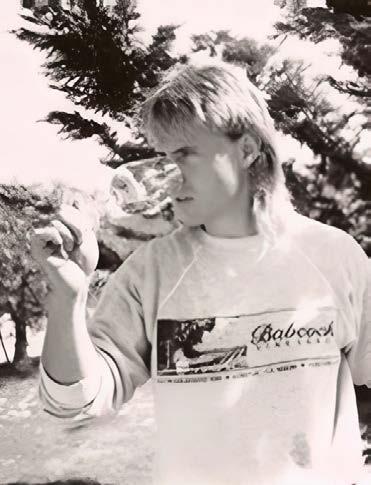
3.
4.
5.


by bob Wesley
Even after 400 years of cultivation, unless you cross the pond to Mediterranean France and sit yourself down in a cafe near the coast, you’ll rarely encounter the delights of this hard-to-imitate grape variety. Imports are far more prevalent in California than homegrowns, but still mighty rare overall in our retail stores or on wine lists. Shame on us!
The Pinet appellation is just 200 miles north of Spain for all you cartographers out there, but the grape hasn’t broadly migrated far outside of its own frontières françaises, though I’m glad to report that a prodigious 68 acres are actually planted in California.
Every pathetic wine geek, including me, knows the answer to this vino trivia question: What does the grape Picpoul (“pick pool”) mean in French? The answer is “lip stinger,” though in Golden State versions, the implied sharper and more tingly attributes of the Languedoc bottlings have been tamed by three extremely adept Santa Barbara winemakers, as described explicitly (but for a family audience) down below. Picpoul and shellfish have thrived as a longtime regional pairing among the French, in a hearty, unpretentious, slurpy, symbiotic relationship that can be flavorsomely replicated stateside. Just grab a glass and shuck a dozen itty-bitty briny oysters on the half shell spritzed with

fresh lemon, or steam pounds and pounds of littleneck clams in buttery herb broth, and don’t skimp on the baked mussels with bread crumbs and parmesan.
Add a baguette to the feast, of course, and seek out the toothsome local trio below.
2022 Turning Tide Picpoul Happy Canyon of Santa Barbara.
Produced by highly experienced but relative newcomer to Santa Ynez, Alisa Jacobson, this ’22 parades an
aromatic maelstrom of crisp pear, green apple, and stony river rock, rather Chablis-like but nowhere near as austere, with added melon and slight citrus orchard playfully elbowing their way in. It’s fresh, forward, and vibrant, with an extended zesty finish and an interplay of every preceding pleasurable nuance, echoing its ancestral Languedoc homebase.
2022 Margerum Picpoul
Blanc Estate Los Olivos District Santa Ynez Valley
Doug Margerum believes in battonage (lees stirring), ideal for balancing the puckery acidity of the varietal. Aromas of mineral, honey, and melony ripeness emerge instantly, and swirling prompts a further and more complex melange of river rock, honey, lime, and Granny Smiths fresh off the tree. A touch of white floral essence appears for further intrigue. This is an affectionate replication of the Mediterranean bottlings I’ve had, with added dimensions but no “stinging.” Babcock 2023 Picpoul “Gracious” Nolan Vineyard Alisos Canyon Santa Maria Valley Voluminous aromatics waste no time in their seduction, with precise orange peel and minerality expressing themselves in this broader-styled version, with succulence that fans out across the palate. Dry but luxurious, with touches of butterscotch, graham cracker, and rounded tangerine mirroring the exquisite and everburgeoning aromas. Seamless, sexy, and ending in a finale that will extend and persevere till bedtime. If you possess or can find Bryan’s bottling of this limited production white, well, you’ve been alerted!

Bob Wesley is a Santa Ynez based wine buying consultant and writer specializing in California wines. You can reach him at maisonbob@aol.com

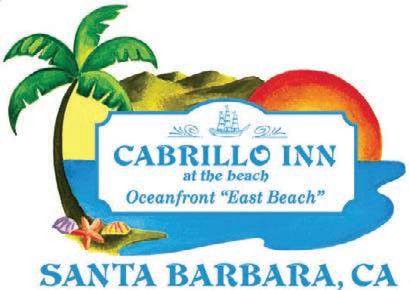

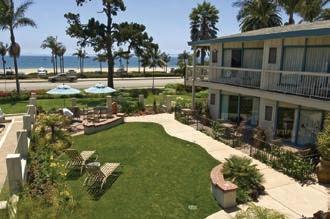
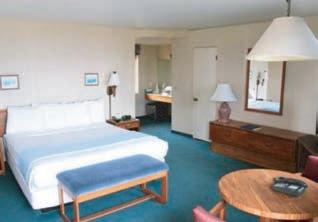

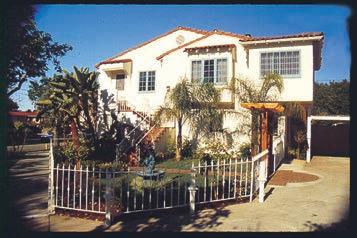

by hana-lee sedgWICk
Ah, fall—a season to truly savor. This time of year, when grape harvest festivities peak, trees display vibrant shades of orange, and excitement builds around the upcoming holidays, our palates naturally shift from light, refreshing wines to richer, more robust and food-friendly varieties. Essentially, wines which complement the cooler nights, heartier meals, and festive holiday celebrations so prevalent this time of year. So, whether you’re curled up by the fire or hosting Thanksgiving dinner, here are five standout wines from the Central Coast to reach for this season.


Peake Ranch Grenache ($75)
Sourced from Peake Ranch’s estate vineyard in the Sta. Rita Hills AVA, this alluring grenache is a lovely pick for the cooler season. Rich on the nose, it immediately captivates with its vibrant raspberry, cranberry, and clove notes. While the palate is on the bolder side, with noticeable tannins, it’s balanced beautifully by the wine’s ample acidity and long, lingering finish, which continually draws you in for another sip. Savor it slowly while curled up with a good book, or pair it with meat dishes all season long.
Tyler Mae Estate Chardonnay ($75)
Crisp, refreshing whites are a staple in summer, but as we get into the cooler months, I enjoy drinking whites that are more complex, yet still offer invigorating minerality. This chardonnay
from Tyler Winery’s Mae Estate effortlessly captures this profile, revealing why chardonnays from the Sta. Rita Hills are so special. Sourced from estate vines located 15 miles from the Pacific, this wine offers a sophisticated blend of complex minerality and textural finesse, beautifully layered with notes of wet stone, sea salt, stone fruit, and delicate florals. There’s no doubt it will delight everyone at your table.
Talley Estate Pinot Noir ($46)
For those who prefer their pinot noir on the brighter, “crunchier” side, this bottling from familyowned Talley Vineyards should hit the spot. Sourced from estate vines along the San Luis Obispo Coast, the wine offers aromas of raspberry and licorice, accented by orange zest and subtle dusty qualities. On the palate, lively red and black fruits are interwoven with earthy undertones,



culminating in a bright, lifted finish. Approachable and enjoyable, it’s a great introduction to Talley’s array of cool-climate Burgundian varieties.
Storm Gamay ($40)
Though Chardonnay and Pinot Noir are fan-favorites this time of year, particularly around the Thanksgiving table, definitely don’t overlook alternative options, such as gamay. This earthy, fruity, and light-bodied red is a joy to drink alongside food, thanks to its high acidity and lower alcohol levels, making it a versatile companion to a broad range of dishes. Ernst Storm’s latest gamay, sourced from Presqu’ile Vineyard, captures the essence of fall with its tantalizing notes of pomegranate, plum, blackberry bramble, and earth. While pleasurable on its own, it’s perfect alongside everything from roasted turkey with all the fixings, to
stews, duck, and even seafood. Serve it with a slight chill for maximum enjoyment!
Dunites Pet Nat ($35)
While classic sparkling wines are a must during the holiday season, there are times when a more affordable, playful option is just right. This unpretentious Pet Nat (Pétillant Naturel) from Dunites is exactly that— a delightful, lightly fizzy wine at an attractive price point. Crafted from organically-farmed grapes grown along the San Luis Obispo Coast, this blend of 73% Pinot Noir and 27% Chardonnay by the husband-and-wife team, Tyler Eck and Rachel Goffinet Eck, reveals tropical and stone fruit flavors accented by hints of brioche. With its fresh, lowalcohol profile, it’s ideally suited for daytime sipping or pairing with appetizers, yet is compelling enough to stand on its own.
We are event specialists and can host your full-service, daytime event (up to 40 people) any day of the week. For all the info, including larger groups and special accommodations, scan this code:




Prefer a night time party?
Our venue can also accommodate larger groups up to 150 people in the evenings. We’ve got you covered!

Open Mon-Fri from 9am–2pm
Weekend Brunch from 9am-2pm
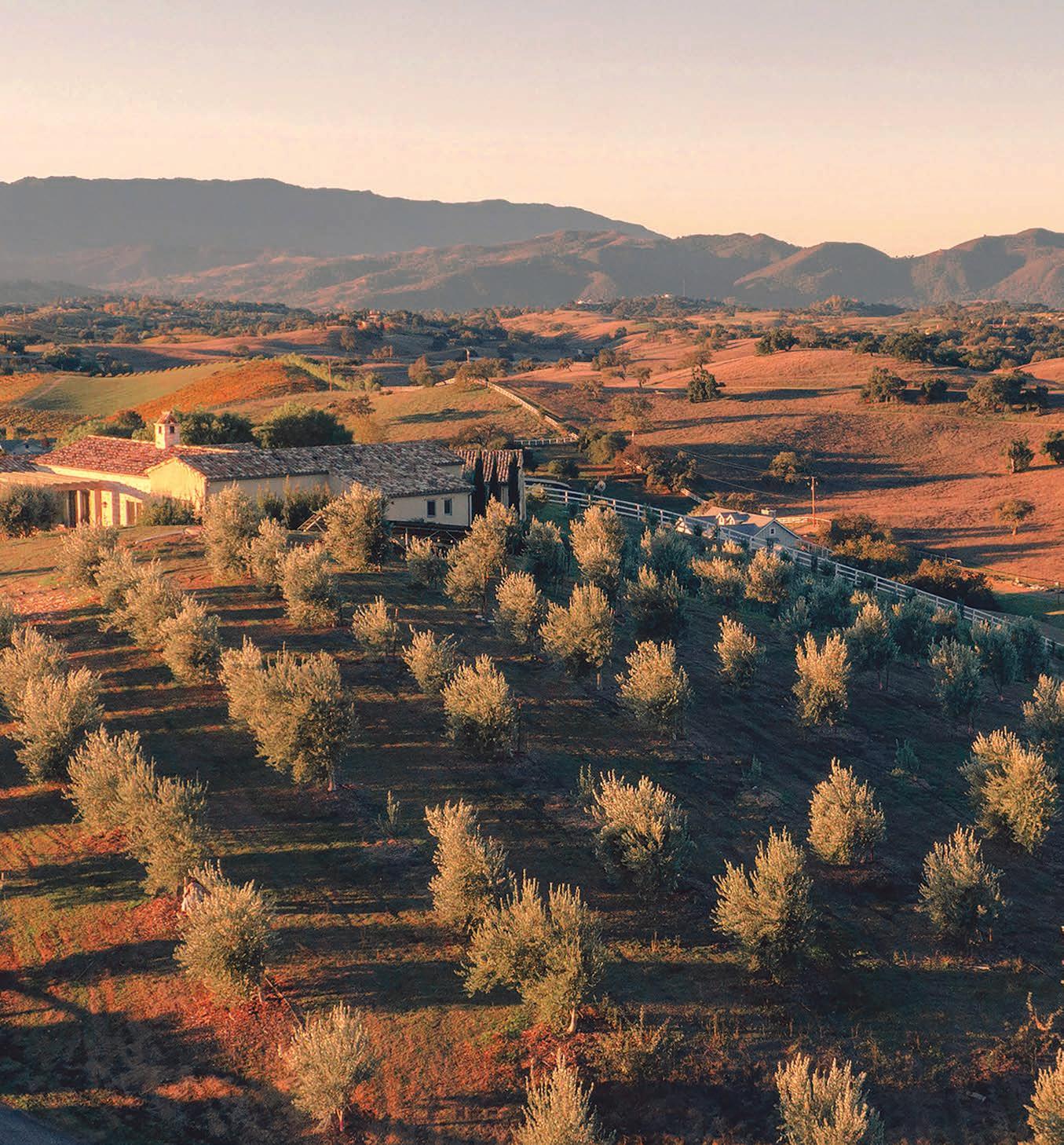
By Leslie Andrea Westbrook
The rolling hills of Ballard Canyon in the Santa Ynez Valley are where Elise Magistro (right) has planted nine varietals of some 1,000 olive trees that produce her award-winning, certified organic extra-virgin olive oil, Luretík.


, known as the father of medicine, called olive oil “the great therapeutic.” Homer deemed it “liquid gold.” Many scientific studies in the past decade have shown that olive oil, which is high in monounsaturated fat — the “good” fat — may prolong life by combating coronary heart disease and different types of cancer. There have also been claims that it could prevent dementia.
There’s more to olive oil than meets the eye, and the palette. Each olive varietal, be it Tuscan, Sicilian or Spanish, has its own distinct flavor. Some are best as finishing oils, others for cooking. There are peppery-with-a-bite versions, some that taste grassy, others that are delicata.
Ask the experts or use your own tastebuds to learn the differences. California, much like Italy and Spain, is a perfect location for planting and harvesting olives. There are excellent olive oil producers from Ojai to the Santa Ynez Valley to Paso Robles and farther north in Napa too, where you’ll find award-winning Jubaea Estate olive oil. (I’m a fan.)
The moment of harvest is important. Harvesting too early can make for a bitter oil, more mature olives produce a sweeter product. So is how and where oil is stored (cool, dark place is best) as well as its lifespan (always
check the production date). It should be used often and generously.
Two super-busy women who are new olive oil producers in the Santa Ynez Valley took a breather to share a bit about their journeys. Here’s a “taste” of what they had to say.
Olive oil producer Elise Magistro, founder of Luretík, working with landscape designer Puck Erickson of Arcadia Studios, has created a bucolic olive orchard at her family's private Ballard Canyon property. The original grove of 100 olive trees has blossomed into eight Italian varieties of some 1,000 trees bearing Nocellara del Belice, Cerasuola, Carolea, Cerignola, Cipressino, Coratina, Frantoio, Itrana and Pendolino olives that are milled into award-winning, internationally recognized, certified organic extra-virgin olive oil. Three of her oils received gold medals in international competitions this year, including a rare Double Gold medal as well as Best World Wide Certified Organic at the Athena International Olive Oil Competition in Sparta, Greece.
With great dedication and a desire to compete against the best European olive oils, Magistro, a retired Italian language professoraturned-farmer, has turned her swath of land into a thriving olive grove producing delicate, medium-fruity, and robust olive oils

that embody the essence of Italian olive oil craftsmanship. Half Sicilian and half French — hence the name Luretík, which means “from my soil” — Magistro has roots, much like her plantings, in the olio tradition. In fact, it’s in her blood. She also makes a mean olive oil cake.
“When I began I had little other than an appreciation for excellent extra virgin olive oil, having spent much time in Italy over the years,” Magistro said. “That, along with very fond memories of growing up in a home where food took center stage most evenings. My Sicilian grandfather generally cooked, and the cornerstone of his cooking was olive oil — the imported kind we would purchase in large tins at our tiny local Italian market.”
Her grandfather, Michele Angelo Magistro, finished every dish with a flourish of oil, handheld high over the plate.
“I may well have subconsciously tapped into that memory when I decided to start producing olive oil after retiring from teaching,” she said.
Whether Magistro was visiting Sicily or Tuscany, she would inevitably end up in someone’s olive grove, where there was always a “fleeting, but visceral connection to those centuries-old trees, a sense of belonging to a far grander, natural order.”
In 2012, Magistro and her husband purchased a 10-acre parcel high above Alamo Pintado Road overlooking Ballard Canyon.
“At sunset that view was akin to looking down from heaven,” Magistro said. “I’ve always felt that the Santa Ynez Valley chose us. It was never my intention to start a business. I simply wanted to make a high-quality oil that could equal the Italian and Sicilian oils I loved.”
Even today, whenever feeling stressed about the “business side” of making olive oil, she strolls her grove to recapture that feeling and to “convince myself that I made the right choice and that the trees need me as much as I need them.”
Down the road a piece, and open to the public five days a week for tastings and events, sits Oil + Lavender. With a background in design, Jennifer Wood, along with her business partner, Randy Spendlove, head honcho of music for Paramount Pictures, discovered the Los Olivos property (formerly Global Gardens) that she intrinsically felt could be “magical.”
“I knew California was amazing for agriculture, but now I know how fantastic the Central Coast is for many crops, especially olives. California olive oil is in demand worldwide,” Wood said. “We live in Los Olivos which means ‘the olives.’ It seemed natural to produce and sell olive oil, one of the world’s oldest culinary products that’s used in so many types of cooking and cuisine. People are finally starting to realize all the great health benefits, too.”
What she’s created, thanks to her background as an interior designer, is an alluring destination of white and bright interior spaces with crystal chandeliers, and exterior grounds that include small pathways for children to wander, areas for relaxation, and a new lavender garden.
The tasting features flavored olive oils, including truffle and basil as well as a range of balsamic vinegars, all identified on a paper placemat so you can choose your favorites.
Knowing they would be reliant on the weather and environment for olive oil production, the duo partnered with small farms so as not to be solely dependent on the olive trees on the property.
“This is a passion project about food, music, friends, and family,” Wood said. “We love bringing people together. It’s all about community and we knew the location would be perfect for people to gather, relax, and experience the ambience and flavor of the Santa Ynez Valley. Once people come to visit and taste, they become as passionate about the products as we are.”
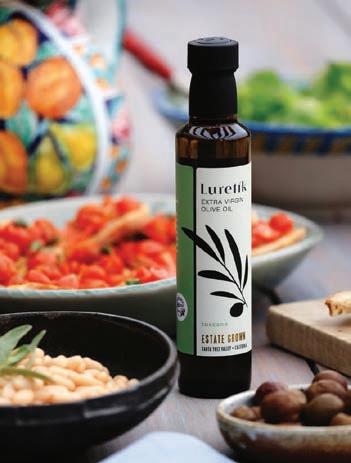
LURETÍK: Award-winning olive oils are available via their website and at domecíl in Victoria Court, Santa Barbara. Luretík oils are used at Nella Kitchen and Bar in Fess Parker’s Los Olivos Inn and Pico’s in Los Alamos. luretik.com
OIL + LAVENDER: 2450 Alamo Pintado Road, Los Olivos. Open Friday – Monday for tastings and purchases. oliveandlavenderfarms.com
GLOBAL GARDENS TASTINGS & PROVISION SHOP: Theo Stephen continues her love of extra virgin olive oils and education in her new Santa Ynez space that focuses on California EVOOs. A resident olive oil sommelier (there are fewer than 400 globally) guides onsite tastings ($10). Global Gardens Tastings & Provisions Shop, 10-5 daily, 3570 Madera St, Santa Ynez,. globalgardensonline.com
SANTA BARBARA OLIVE OIL
CO.: Sold at Santa Barbara Farmers Markets. sbolive.com
RANCHO OLIVOS: Farm stay accommodations available on the 20-acre olive ranch where also roam dogs, cats, chickens, and horses. ranchoolivos.com







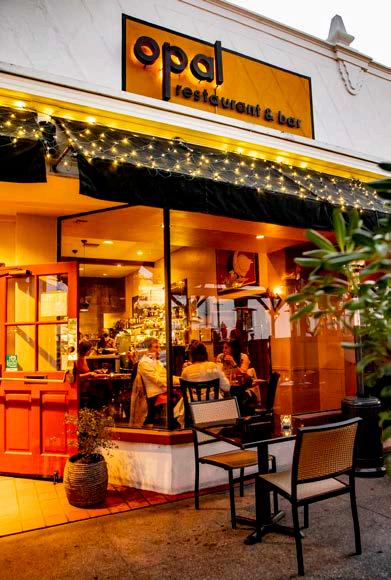
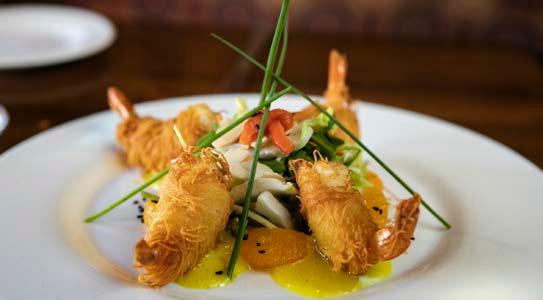


Serves 2, plus leftovers
Ingredients:
1 whole chicken, split in half,
backbone removed
kosher salt
2 tsp. pimentón (smoked paprika)
2 tablespoons olive oil, plus more if needed
freshly ground black pepper thyme
2 lemons, cut in half
1 head of garlic, cut in half
1 shallot, minced
1 cup chicken stock for deglazing pan
Instructions:
1. Dry brine the chicken 1 to 2 days day before serving. Dry the chicken very well. Season the chicken liberally all over with salt. (use ~3/4 teaspoon sea salt per pound of chicken). Cover loosely and refrigerate.
This Grenache from the Lyons Vineyard in the Los Olivos AVA is delightful, well balanced, and a perfect pairing to the 48-hour roasted chicken recipe on the opposite page. Showcasing aromas of dark berries, plum, and clove spice, this medium-bodied wine is aged 18 months in French oak, producing a rich palate with hints of vanilla, cola, and cherry.
Available at Carr Winery, 414 N Salsipuedes St, Santa Barbara. www.carrwinery.com

2. Remove chicken from refrigerator 1 hour before roasting.
3. Preheat oven to 450° F. Season the chicken all over with the pimentón and olive oil. Set aside. (Use your hands to massage the smoked paprika and olive oil into all parts of the chicken; use more if needed).
Season with freshly cracked black pepper.
4. Transfer chicken breast side up to a large oven-safe skillet. Arrange thyme, lemon and garlic (cut sides down) in skillet around chicken. Transfer to oven. Roast until chicken is nicely browned and cooked through, checking for doneness after ~45 or so minutes. (I like to check at the halfway mark and baste the chicken if needed (brush with olive oil from the bottom of the pan and place back in oven).
To check, carefully remove skillet from oven (the handle is hot!), poke a knife into leg joints, and pierce the meat.


If juices run clear, the chicken is done. If you see a rosy pink color, it needs more time. Continue to roast, checking every 5 minutes, until juices run clear (165 degrees internal temp on a meat thermometer).
5. Carefully remove chicken, garlic, lemon and thyme from the pan, leaving behind any pan juices. While the chicken rests and cools, make your pan sauce. Using the same pan, sauté shallot over medium heat until translucent. Deglaze with chicken stock and continue to cook until reduced and the sauce is thickened slightly. Carve the chicken into 8 pieces and transfer to a platter. Pour the pan sauce over the chicken and serve with roasted lemon and garlic alongside.
Recipe, photo and styling by Katherine Knowlton, private chef, caterer and founder of Happy Chance Edibles www.eathappychance.com


The term “comfort food” (added to the Webster's Dictionary in 1972) is defined as foods consumed to achieve some level of improved emotional status. The fall seems to bring out the best in all of that.
Roasted vegetables and hummus
Hummus
Ingredients:
2 cloves garlic, divided
1 (19 ounce) can garbanzo beans, half the liquid reserved
4 tablespoons lemon juice
2 tablespoons tahini
1 teaspoon salt
black pepper to taste
2 tablespoons extra virgin olive oil
Directions
In a food processor or blender, chop garlic. Pour garbanzo beans into the blender, Add reserved liquid, lemon juice, tahini, and salt to the blender. Blend until creamy and well mixed.
Transfer the mixture to a medium serving bowl. Sprinkle with pepper and pour olive oil over the top.
Roasted vegetables
Ingredients
1 15 oz. can chickpeas, drained and rinsed
4 tablespoons extra virgin olive oil
½ teaspoon salt
¼ teaspoon black pepper
1 large carrot, peeled and cut into thin sticks
2 large beets, peeled and cubed
2 fennels, cut into wedges
1 large onion, sliced into rings
1 sweet potato, cubed
1 bunch (about 10) baby red or purple potatoes, halved or quartered
6-8 tablespoons olive oil
1 ½ teaspoons salt
¾ teaspoon black pepper
¼ teaspoon cayenne pepper, optional
Directions
Preheat oven to 375° F. Line a baking sheet with parchment paper. Spread chickpeas onto sheet in single layer and toss with the olive oil, salt, and pepper. Roast till crunchy, 30-40 minutes, tossing halfway through. Meanwhile, cut the vegetables according to instructions. Line a large baking sheet with parchment paper (or 2 if necessary) and spread the vegetables in a single layer on the sheet. Toss with the olive oil, salt, pepper, and cayenne and roast until tender and golden brown, 45-60 minutes (once chickpeas leave oven, raise oven temp. to 425° F till veggies finish roasting).
Prepare pomegranate seeds, pine nuts, and herbs.
In a measuring cup, whisk together the olive oil, balsamic vinegar, maple syrup/honey, and salt.
Spread hummus onto surface of a medium serving board (round works well too, a board with ridges to contain the glaze is best). Top with the roasted vegetables, then the roasted chickpeas.
Garnish with the pomegranate seeds, pine nuts, and herbs. Drizzle with the balsamic glaze. Serve.
Yield: 8-10 servings

This marinade is amazing for accentuating the flavor of our local black cod. Santa Barbara Fish Market executive Chef, Paul Osborne recommends marinating the cod for 24 hours and then cooking it on high in a 400-degree oven over foil (shiny side up!) to achieve a deep caramelization and incredible texture.
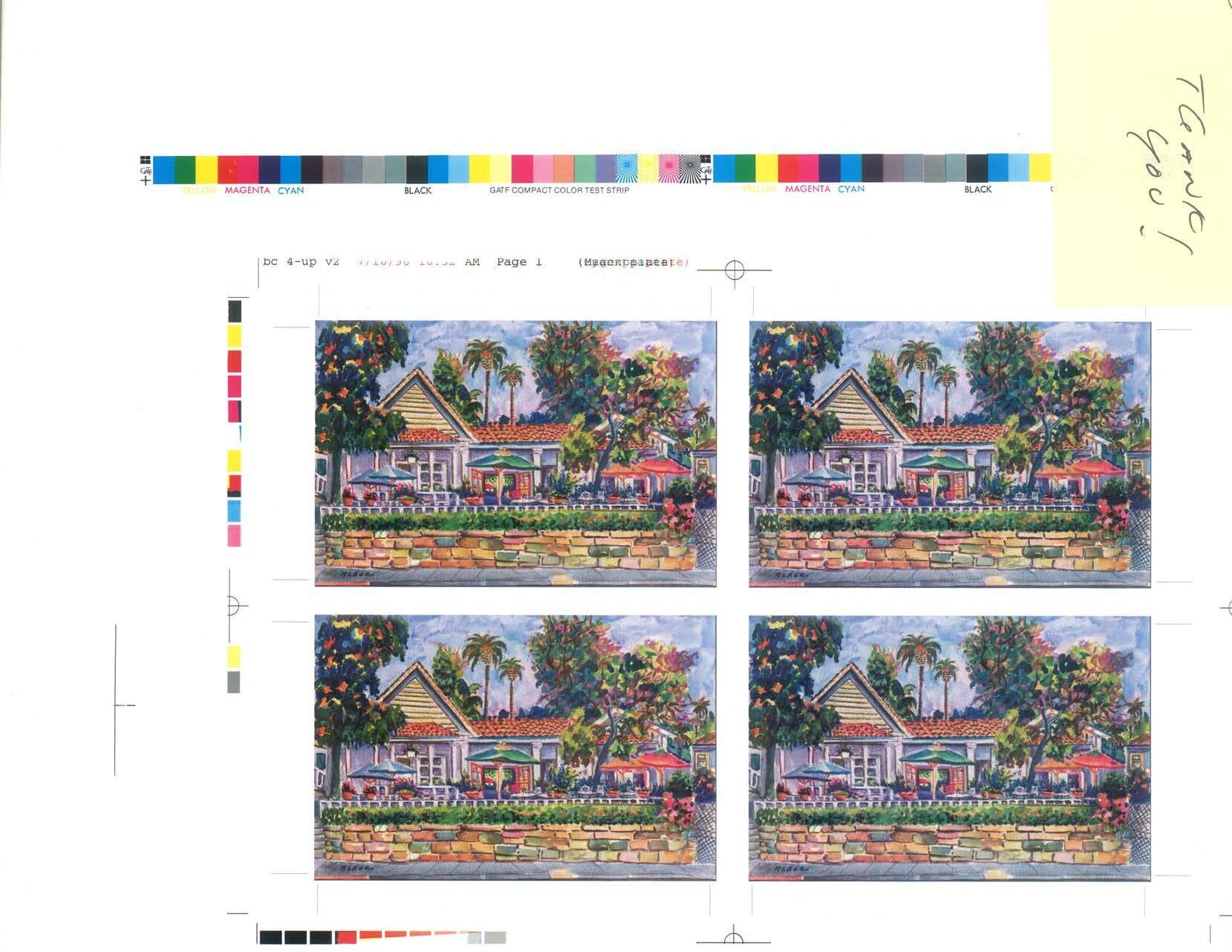
This marinade will work for many other fish varieties as well, including ling cod and salmon.
Ingredients
2 cups sake (we recommend a Junmai)
2 cups Takara Mirin (available at any Asian grocer)
2 cups white miso paste
1.5 cups coconut sugar (or any natural granulated sugar)
1 cup orange juice
Directions
Whisk together all ingredients until the sugar and miso are dissolved.
This will last for 2 weeks in a tightly sealed container in the refrigerator. Use it to marinate your favorite fish and enjoy!
www.sbfish.com


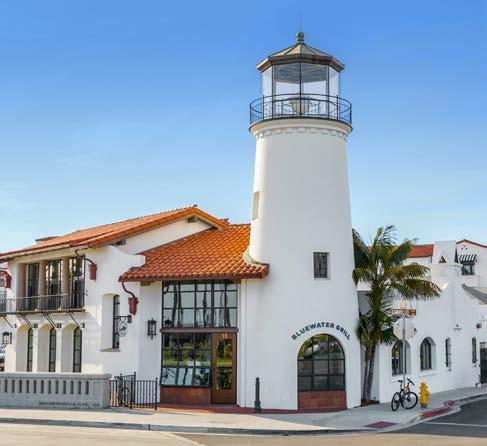



1 Olio e Limone
Burrata Primaverile. www.Olioelimone.com
2 Bluewater Grill
Bluewater Roll
Spicy tuna, cucumber, and avocado topped with hamachi sashimi, masago, and ponzu
3 bouchon
Pacific ahi tuna. www.bouchonsantabarbara.com
4 The Natural Café
House favorite chef’s salad. www.thenaturalcafe.com
5 Petit Valentien
Parmesan and fennel salad. www.petitvalentien.com
6 Holdren’s Steak & Seafood
Prime filet paired with Carr Winery Pinot Noir. www.holdrens.com
7 Scarlett Begonia
French toast with whipped mascarpone, fresh berries, and almonds. www.scarlettbegonia.net
8 Opal Restaurant & Bar
Shredded phyllo wrapped tiger prawns. www.opalrestaurantandbar.com
9 The Black Sheep
Seared local albacore “crudo” with market citrus, spicy greens, Umbrian oil, and fresh horseradish. www.blacksheep.com

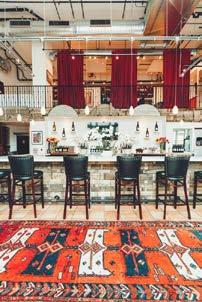

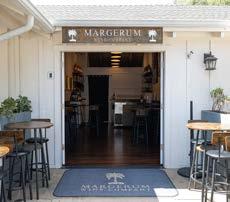









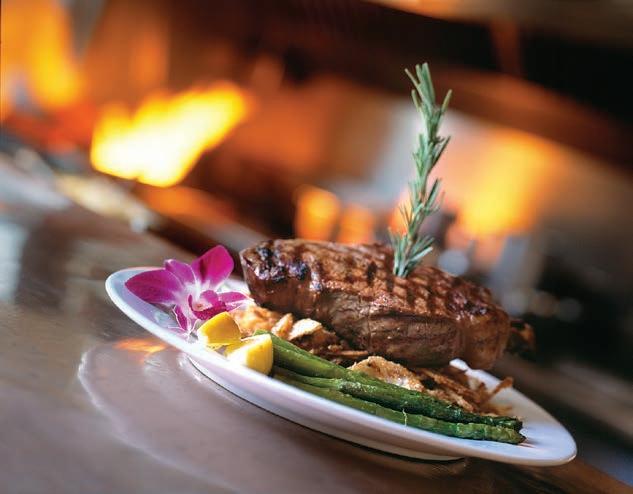
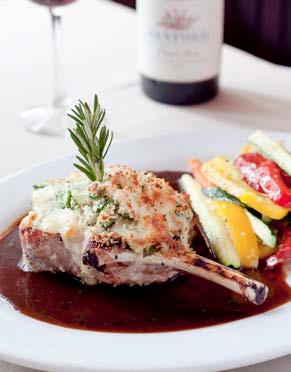


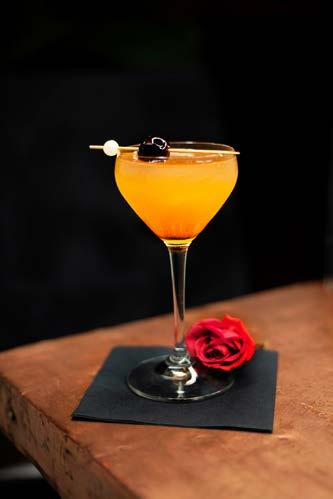
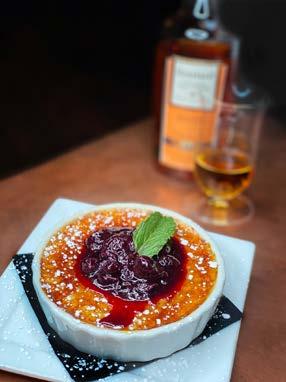

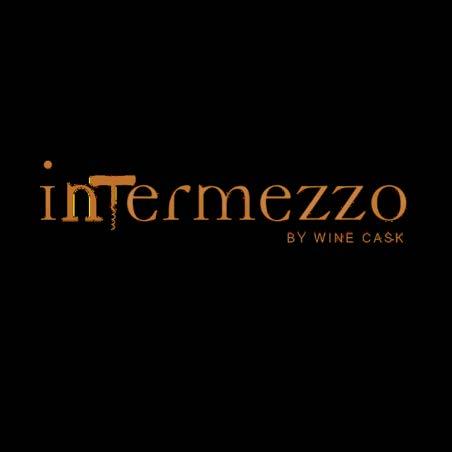


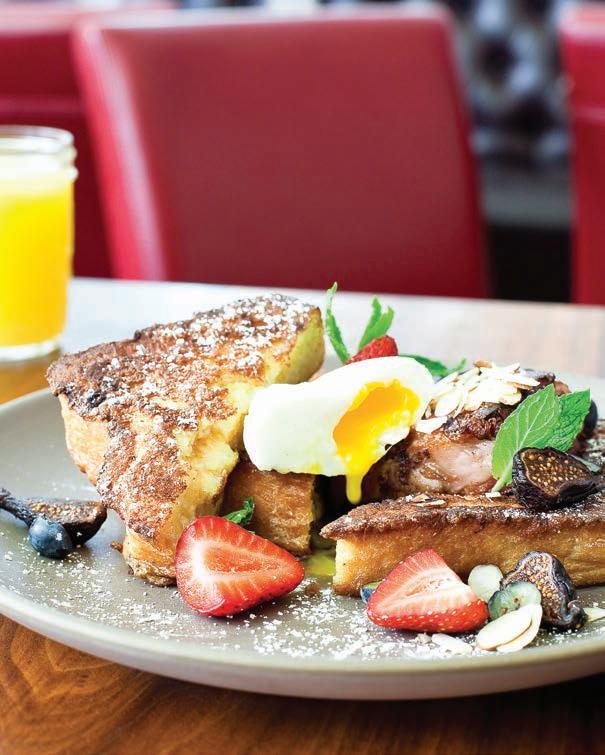

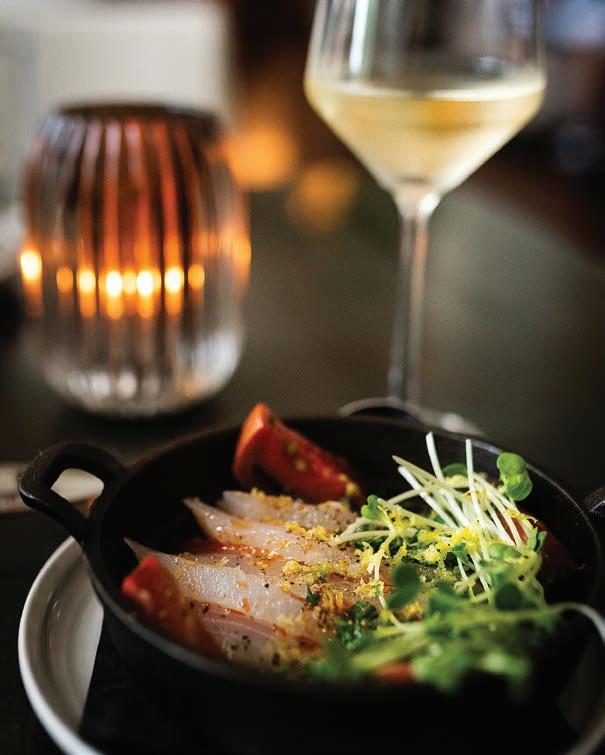
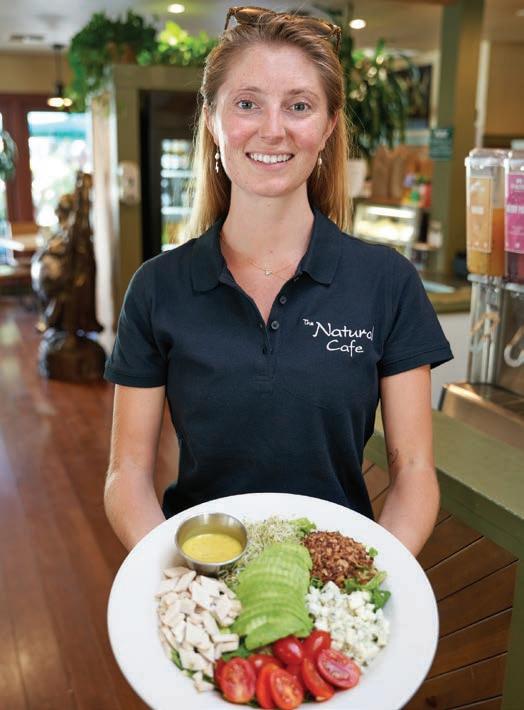


One of the oldest restaurants in Santa Barbara, Arnoldi’s Cafe was founded by Giuseppe and Ilda Arnold in 1937, at 421 East Cota Street. In 1940, Giuseppe (Joe) quarried local stone and built the present restaurant at 600 Olive Street. Since then, Arnoldi’s, with the bocce ball courts in the garden, has been entertaining Santa Barbarans and visitors from all over the world.
Book your holiday or special occasion party today. Room for up to 125. Daytime weddings and baby showers. Birthdays and anniversaries.
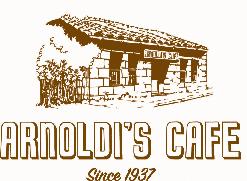
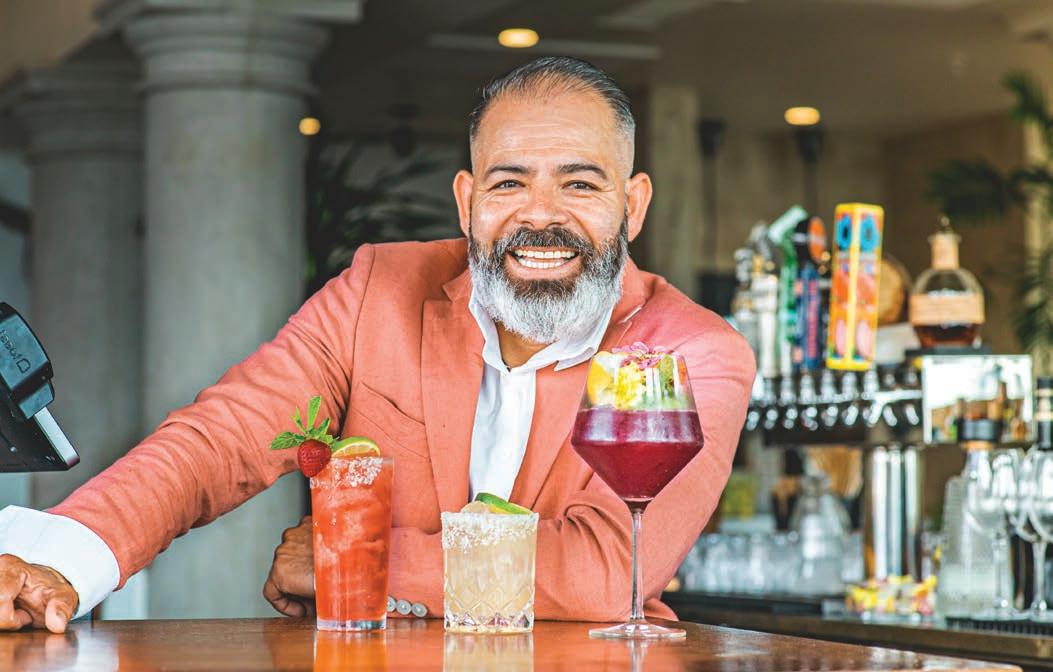
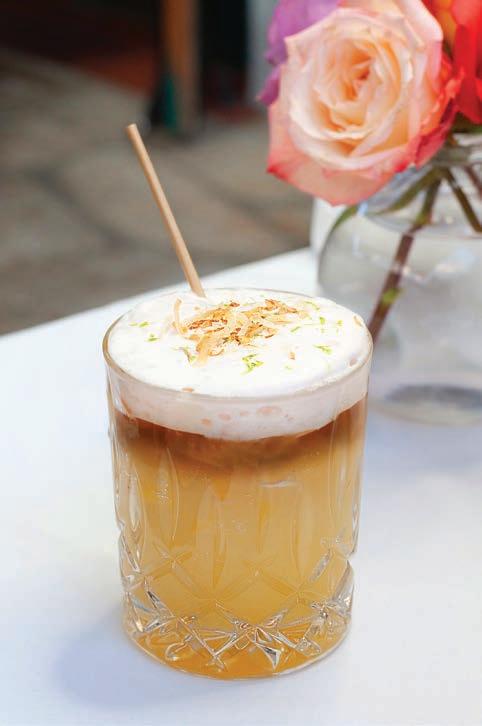
3 4
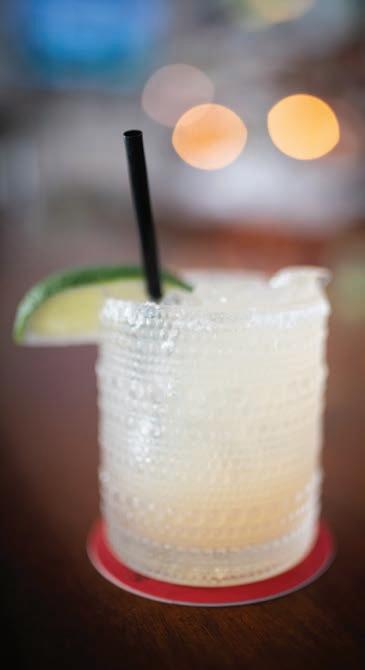
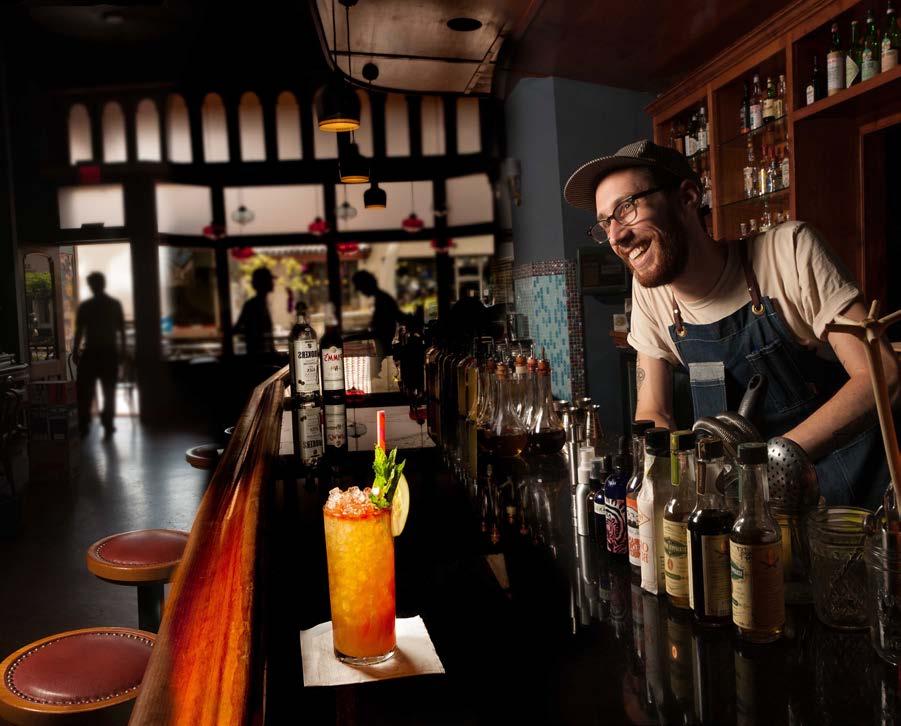


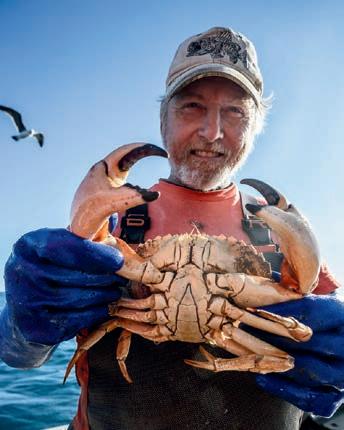




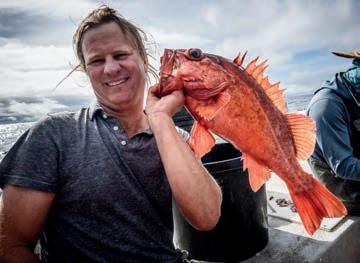

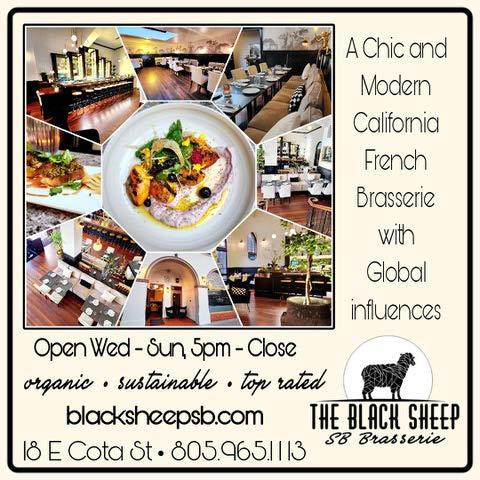
by bob Wesley
Consider winemakers during harvest, those sleep-deprived, grape-obsessed lunatics who make Ahab’s unhinged oceanic quest for the white whale look like a mere beer-fueled weekend fishing trip for rainbow trout on Lake Cachuma.
Picture this: It’s a vineyard at 3 a.m. in August, or September, or October (and some years all three), pitch-black save for the glow of tractor headlights bobbing through the vineyards like alien spaceships attempting another abduction of humankind. Luckily, our inferiority as a species means we always get spat back out of the spacecraft like a sip of Franzia White Zin.
Anyway, amidst the farming equipment’s engine roar and grape-plucking chaos stand the head vinomeisters, knee-deep in dewsoaked terroir, muttering semi-coherently to themselves about Brix levels and phenolic maturity. They’ve been up since yesterday, fueled by a potent cocktail of caffeine, passion, and the latest profit and loss statements that their accountant Sid left under their door the night before.
Sleep? Ha! That’s for people who don’t have temperamental, mercurial, pain-inthe-@$$ pinot noir threatening to overripen if they so much as take a lil nap. Their aide-de-camp stands nearby dispensing encouragement, advice, and espresso shots from a Stanley thermos as the boss points and shouts disjointed commands to the picking crew. They’ve heard this spate of foolishness for years and ignore it because they know better.
Unpredictability is the only constant. In a worst-case scenario, if rain is suddenly forecast, all of them will swiftly be locked in a high-stakes game of chicken with Mother Nature, and they’re not about to let Ma kick them in the butt with any curveballs. Or the other way around, sans the curve. And the butt.
Assuming that even if all goes well, as dawn breaks, you’ll find the head honcho, the one with their name on the label, hunched over clusters of grapes, feverishly squinting at them like a jeweler with an eye loupe examining the Hope Diamond.
They’ll pop one in their mouth, swish
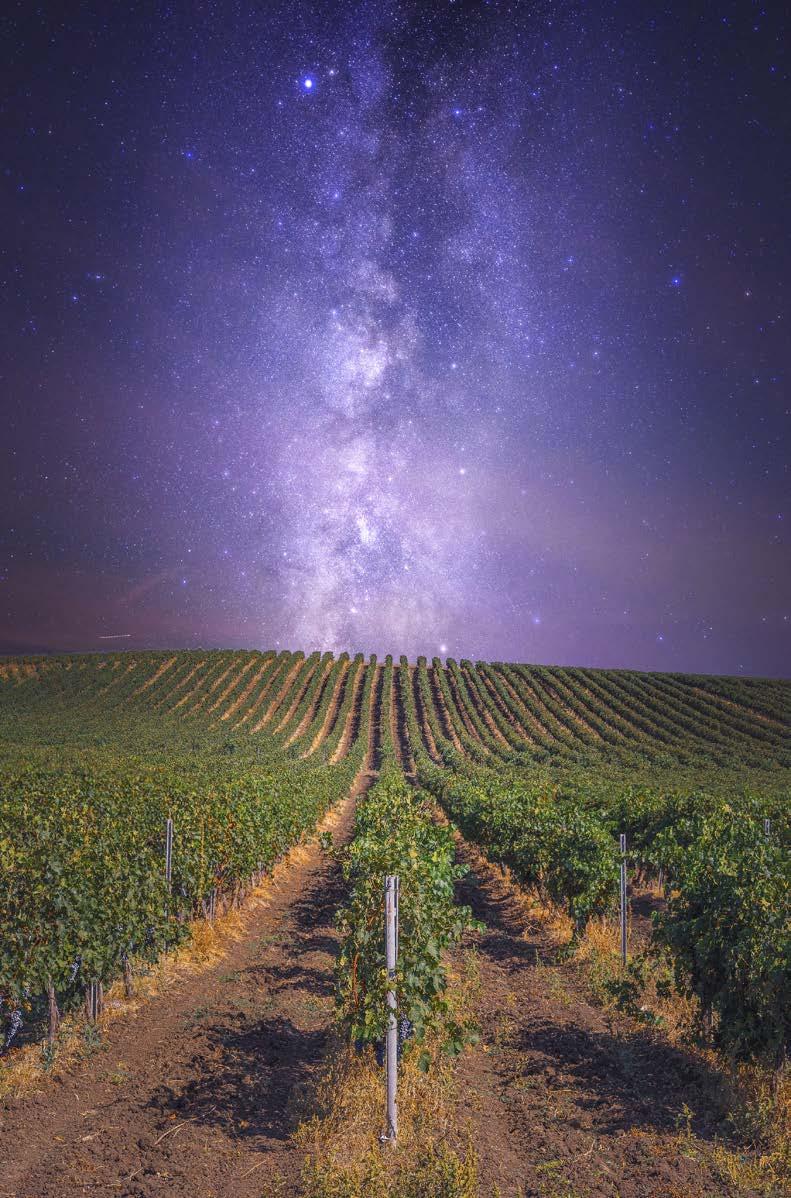
it around with a furrowed, sweaty brow and the intensity of a bomb disposal expert cutting wires, then spit it out and scribble cryptic notes. “Hint of eucalyptus ... touch of minerality ... why did Sid circle ‘labor costs’ in so much red ink on the expenses line?”
Yes, for part of the year, late summer and into fall during harvest, winemakers and their crews morph into unsteady but unstoppable zombies, stumbling through
vineyards at odd hours seeking perfectly ripe flesh, not of their fellow man, just of their fruit. Avoid them at this time of year, as they are all truly, the undead.
Bob Wesley is a Santa Ynez based wine buying consultant and writer specializing in California wines. You can reach him at maisonbob@aol.com
by Daniel


